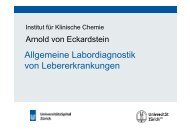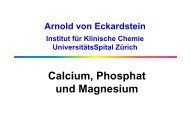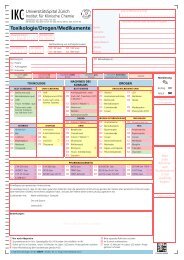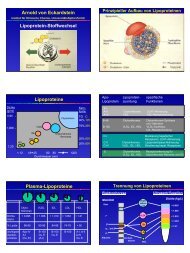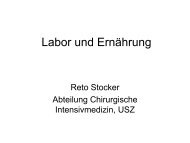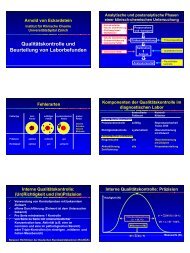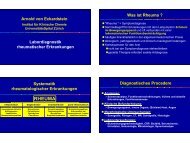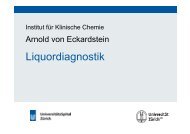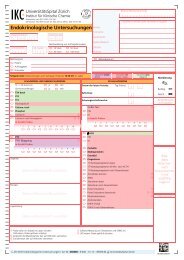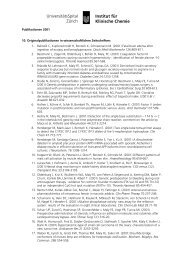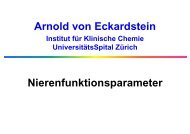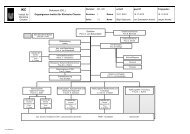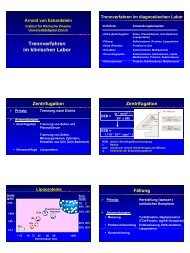2006 - Institut für Klinische Chemie - UniversitätsSpital Zürich
2006 - Institut für Klinische Chemie - UniversitätsSpital Zürich
2006 - Institut für Klinische Chemie - UniversitätsSpital Zürich
Erfolgreiche ePaper selbst erstellen
Machen Sie aus Ihren PDF Publikationen ein blätterbares Flipbook mit unserer einzigartigen Google optimierten e-Paper Software.
Akademischer Bericht <strong>2006</strong><br />
<strong>Institut</strong> <strong>für</strong> <strong>Klinische</strong> <strong>Chemie</strong><br />
Leitung in der Berichtsperiode:<br />
Prof. Arnold von Eckardstein<br />
Raemistrasse 100<br />
8091 ZUERICH<br />
+41 44 255 2260<br />
E-Mail arnold.voneckardstein@usz.ch
Zusammenfassung (Management Summary)<br />
Die Forschung des <strong>Institut</strong>es <strong>für</strong> <strong>Klinische</strong> <strong>Chemie</strong> (IKC) umfasst die klinisch-orientierte Grundlagenforschung<br />
und klinische Anwendungsforschung auf den Gebieten zellulärer Lipid- und Lipoproteinstoffwechsel<br />
und kardiovaskuläre Krankheiten sowie die Entwicklung und Evaluation von Technologien, Methoden<br />
und Parametern <strong>für</strong> die Molekulare Diagnostik und den Nachweis von Medikamenten und Lipiden.<br />
Neben diesen proprietären Forschungsprojekten gibt es formale mit Drittmitteln geförderte oder als<br />
Teil von Netzwerken und Kompetenzzentren der UZH durchgeführte Kooperationsprojekte wie auch lose<br />
Kooperationen. Im Berichtszeitraum publizierten die WissenschaftlerInnen des IKC 27 Original- und<br />
4 Übersichtspublikationen mit zusammen mehr als 120 Impact-Punkten sowie 4 (Lehr-)buchbeiträge.<br />
Zudem warben sie <strong>für</strong> mehr als 1.5 Millionen CHF Drittmittel ein. Drei Naturwissenschaftler schlossen<br />
ihre Promotionen erfolgreich ab.<br />
Die Lehre umfasst die Ausbildung von Studierenden der Medizin und Naturwissenschaften (UZH), der<br />
Pharmazeutischen Wissenschaften (ETH <strong>Zürich</strong>), der Medizintechnik (Fachhochschule Bern) und von<br />
Medizinischen BioanalytikerInnen im Fach „<strong>Klinische</strong> <strong>Chemie</strong>“ und in den wissenschaftlichen Schwerpunkten<br />
des <strong>Institut</strong>es, sowie die Weiterbildung und Fortbildung von KandidatInnen der FAMH (Foederatio<br />
Analyticorum Medicinalium Helveticorum) und Fachärzten durch Ausrichtung von zwei- bis dreitägigen<br />
Blockkursen. Die Präsenz der <strong>Klinische</strong>n <strong>Chemie</strong> und der Laboratoriumsmedizin im reformierten<br />
Medizinstudium wurde durch weitere Vorlesungen und einen neuen Kurs ”<strong>Klinische</strong> <strong>Chemie</strong>” weiter verstärkt.<br />
Als Dienstleistung bietet das <strong>Institut</strong> <strong>für</strong> <strong>Klinische</strong> <strong>Chemie</strong> eine qualitativ hochstehende Labordiagnostik<br />
<strong>für</strong> die Patientenversorgung und klinische Forschung insbesondere <strong>für</strong> das <strong>UniversitätsSpital</strong> <strong>Zürich</strong><br />
(USZ) aber auch <strong>für</strong> externe Kunden an. Für mehr als 400 verschiedene Parameter wurden in <strong>2006</strong> mehr<br />
als 2.2 Millionen Analysenresultate mit einem Wert von mehr als 37 Millionen Taxpunkten erarbeitet.<br />
Das Ziel aller Anstrengungen ist es, durch interdisziplinäre Zusammenarbeit mit Labordiagnostikern,<br />
Klinikern, Wissenschaftlern und der Industrie das <strong>Institut</strong> <strong>für</strong> <strong>Klinische</strong> <strong>Chemie</strong> auf den Gebieten Diagnostik,<br />
Forschung und Lehre zu hohem nationalen und internationalen Ansehen zu bringen. Anlässlich<br />
der Evaluation durch die Universität bescheinigten die internationalen Experten dem <strong>Institut</strong> <strong>für</strong> <strong>Klinische</strong><br />
<strong>Chemie</strong> eine ausserordentlich hohe Qualität in Dienstleistung, Forschung und Lehre.<br />
1 Allgemeine Einschätzung<br />
1.1 Wo stehen wir heute: Standortbestimmung<br />
Das <strong>Institut</strong> <strong>für</strong> <strong>Klinische</strong> <strong>Chemie</strong> (IKC) des Universitätsspitals <strong>Zürich</strong> (USZ) ist ein selbständiges <strong>Institut</strong>.<br />
Sein Arbeitsteam erbringt Leistungen zugunsten des Spitals, der Universität, externer Kunden und<br />
Kooperierender. Es hat drei Aufgabenbereiche:<br />
– Forschung<br />
– Lehre<br />
– Dienstleistung zugunsten des USZ und Dritter<br />
Seine Aufgaben umfassen die Entwicklung, Erprobung, Ein- und Durchführung klinisch-chemischer und<br />
labormedizinischer Analysen zur Unterstützung von Prävention, Diagnose und Therapie von Krankheiten,<br />
die Erforschung biochemischer Vorgänge im Körper von Gesunden und Kranken und die Aus-,<br />
Weiter- und Fortbildung des wissenschaftlichen und technischen Nachwuchses auf allen Stufen. Das<br />
IKC hat sich als umsatzstärkstes klinisch-chemisches Spitalinstitut in der Schweiz etabliert und kann<br />
auf folgende Erfolge in der Dienstleistung aufbauen :<br />
– Erstes im <strong>UniversitätsSpital</strong> <strong>Zürich</strong> akkreditiertes diagnostisches <strong>Institut</strong><br />
<strong>Institut</strong> <strong>für</strong> <strong>Klinische</strong> <strong>Chemie</strong><br />
Akademischer Bericht <strong>2006</strong><br />
2
– Ersteinführung neuer Analysemethoden und Diagnoseparameter und dadurch zeitweise einziger<br />
Anbieter <strong>für</strong> etliche Spezialanalysen<br />
– Entwicklung eigener Methoden insbesondere <strong>für</strong> die Bereiche Medikamenten- und<br />
Nukleinsäureanalytik und einziger Anbieter in der Schweiz <strong>für</strong> das Monitoring bestimmter<br />
Medikamente und die Bestimmung einiger Genotypen<br />
– Integration der Analytik von mehreren dezentralen Speziallaboratorien der Kliniken des USZ<br />
– in <strong>2006</strong> mehr als 2.2 Millionen berichtete Analyseergebnisse mit einem Marktwert von mehr als 37<br />
Millionen Taxpunkten<br />
Anlässlich der Evaluation wurde die ausserordentliche Qualität der Dienstleistung des <strong>Institut</strong>es <strong>für</strong> <strong>Klinische</strong><br />
<strong>Chemie</strong> von den Experten hervorgehoben: „The institute is based on a highly motivated lab staff.<br />
The director is an internationally recognized expert in clinical chemistry. Drug monitoring is unique. The<br />
organisation and management of the lab is outstanding and documented by its accreditation.”<br />
Vor dem Amtsantritt des jetzigen <strong>Institut</strong>sdirektors im Oktober 2001 gab es keinen eigentlichen wissenschaftlichen<br />
Schwerpunkt im <strong>Institut</strong> <strong>für</strong> <strong>Klinische</strong> <strong>Chemie</strong>. Seit 2002 wurden die analytischen Labore<br />
<strong>für</strong> Chromatgraphie und Massenspektrometrie sowie Molekulargenetik ausgebaut und ein Labor <strong>für</strong> die<br />
biochemische, zell- und molekularbiologische Grundlagenforschung eingerichtet, neue Forschungsgruppen<br />
initiiert, Wissenschaftler und Doktoranden rekrutiert, Drittmittel in der Höhe von mehr als 2.5 Mio<br />
CHF (davon 80% kompetitiv) eingeworben und Forschungsergebnisse in Originalarbeiten publiziert. Die<br />
erste Generation von Doktoranden hat ihre Promotionen erfolgreich abgeschlossen. Zwei Wissenschaftler<br />
des <strong>Institut</strong>es habilitierten sich. Ausserdem wurde ein Netzwerk gut funktionierender Kooperationen<br />
aufgebaut (z.B. Kliniken <strong>für</strong> Kardiologie, Gastroenterologie und Diabetologie/Endokrinologie oder <strong>Institut</strong>e<br />
<strong>für</strong> <strong>für</strong> Pharmazeutische Wissenschaften und Mechanik der ETHZ, Competence Center for Systems<br />
Physiology and Metabolic Diseases , Zentrum <strong>für</strong> Integrative Humanphysiologie). Die Evaluationsexperten<br />
der Universität bewerteten die Anzahl und Qualität der Publikationen aus dem <strong>Institut</strong> <strong>für</strong> <strong>Klinische</strong><br />
<strong>Chemie</strong> als „very satisfactory for the group size“ und die bibliometrische Analyse ergab einen überdurchschnittlichen<br />
hohen Quotienten <strong>für</strong> die Anzahl tatsächlicher Zitationen / erwartete Anzahl Zitationen.<br />
Auch andere Indices weisen die überdurchschnittlich gute Publikatonstätigkeit der <strong>Institut</strong>smitarbeiter<br />
aus.<br />
In der Lehre ist das <strong>Institut</strong> <strong>für</strong> <strong>Klinische</strong> <strong>Chemie</strong> traditionell sehr stark in der Weiterbildung und Fortbildung<br />
von Laborleitern (Foederatio Analyticorum Medicinalium Helveticorum) engagiert, nicht nur durch<br />
die praktische Lehre im <strong>Institut</strong>, sondern auch durch Ausrichtung von Kursen im Rahmen des tronc commun.<br />
Ausserdem wurde das Fach <strong>Klinische</strong> <strong>Chemie</strong> in einem begrenzten Rahmen bei Medizinstudenten<br />
und in einem grösseren Rahmen bei Studierenden der Pharmazeutischen Wissenschaften unterrichtet.<br />
Das <strong>Institut</strong> <strong>für</strong> <strong>Klinische</strong> <strong>Chemie</strong> setzt sich aktiv und erfolgreich <strong>für</strong> die verstärkte Berücksichtigung<br />
seines Fachgebietes im reformierten Medizinstudium und um die Einbindung seiner wissenschaftlichen<br />
Spezialkompetenzen in die Lehre bei Medzinern (Biochemie, Innere Medzin, Mantelstudium) und Naturwissenschaftlern<br />
(Molekulare Medizin, Humanbiologie) ein. Der Einsatz <strong>für</strong> die Lehre hat sich von<br />
25 Stunden in 2001 auf 300 Stunden in <strong>2006</strong> erhöht. Die Experten der Evaluation stellten in ihrem Bericht<br />
fest: „Overall it is clear that the <strong>Institut</strong> <strong>für</strong> <strong>Klinische</strong> <strong>Chemie</strong> under the leadership of Professor von<br />
Eckardstein is strongly motivated to provide a very ambitious and broad teaching program to a wider range<br />
of medical and biomedical students. The interdisciplinary area of clinical chemistry is especially well<br />
suited to form important bridges between clinical and theoretical medicine as well as natural sciences.<br />
The institute clearly has the mission and vision and should be supported to develop this further”<br />
Insgesamt bescheinigten die internationalen Experten dem <strong>Institut</strong> <strong>für</strong> <strong>Klinische</strong> <strong>Chemie</strong> eine<br />
ausserordentlich hohe Qualität in Dienstleistung, Forschung und Lehre.<br />
1.2 Wo wollen wir hin: Ziele in den nächsten Jahren<br />
Vordringliche Ziele <strong>für</strong> die Zukunft sind der fortgesetzte Aufbau eines international kompetitiven Forschungslabors,<br />
die bessere Repräsentanz des Faches <strong>Klinische</strong> <strong>Chemie</strong> bzw. Laboratoriumsmedizin im<br />
Medizinstudium und die Optimierung und Effizienzsteigerung der Labordiagnostik im USZ sowie die interdisziplinäre<br />
Zusammenarbeit mit Klinikern und Labordiagnostikern. Das IKC will seine führende Rolle<br />
<strong>Institut</strong> <strong>für</strong> <strong>Klinische</strong> <strong>Chemie</strong><br />
Akademischer Bericht <strong>2006</strong><br />
3
in der Laboratoriumsdiagnostik innerhalb des USZ und der Schweizer Spitäler sichern und ausbauen.<br />
Hierzu sollen die vorhandenen Qualitäten des IKC erhalten, wenn nötig optimiert und neue Ziele verfolgt<br />
werden:<br />
Forschung<br />
– Aufbau einer Identität auf den Gebieten der klinischen Forschung und Grundlagenforschung im<br />
Bereich der Lipidstoffwechsel- und Herz-Kreislauf-Erkrankungen und der Methoden- und<br />
Technologie-Entwicklung<br />
– Etablierung als international, konkurrenzfähiges <strong>Institut</strong> in Bezug auf Publikationen, Drittmittel und<br />
Patente<br />
– Sicherung und Optimierung des Status als attraktiver Partner <strong>für</strong> klinische Forscher und<br />
Grundlagenwissenschaftler lokal, national und international<br />
Lehre<br />
– Etablierung der <strong>Klinische</strong>n <strong>Chemie</strong> und Labormedizin im reformierten Medizinstudium und<br />
Festigung der Zusammenarbeit mit der ETHZ im Pharmaziestudium<br />
– Einbringung der wissenschaftlichen Spezialkompetenzen der IKC-Mitarbeiter in die Lehre der UZH<br />
(Medizin, Biochemie, Humanbiologie)<br />
– Sicherung und Optimierung der Schlüsselrolle in der Weiterbildung der FAMH<br />
– Sicherung und Optimierung der Situation als attraktiver Aus- und Weiterbildungsplatz <strong>für</strong><br />
Wissenschaftler, Medizinische Laboranten und FAMH Kandidaten<br />
Dienstleistung<br />
– Sicherung und Optimierung des Angebotes aktueller und spezieller Labordiagnostik sowie der<br />
Zuverlässigkeit und Schnelligkeit der Laboranalytik<br />
– Sicherung und Optimierung der Fach-Kompetenz und deren Darstellung nach aussen<br />
– Organisatorische und betriebswirtschaftliche Optimierung der Labordiagnostik im USZ insgesamt<br />
1.3 Wie kommen wir dahin: Strategien, Massnahmen<br />
Die Strategien und Massnahmen des IKC in der Verfolgung der obengenannten Ziele in der Dienstleistung<br />
wurden 2003 in einem von der Spitalleitung des USZ genehmigten Strategiepapier fixiert und seitdem<br />
in einer Mittelfristplanung und 2 Jahresplanungen verfeinert und sollen hier nicht ausgeführt werden.<br />
In der Forschung werden folgende Strategien verfolgt und Massnahmen ergriffen:<br />
– Fortsetzung von Grundlagen-Forschungsprojekten zum HDL-Transport, zur Sphingolipidsynthese<br />
und zur Lipidoxidation. Zwei der drei Projekte werden mit Drittmitteln des Schweizer Nationalfonds<br />
unterstützt.<br />
– Aufbau der massenspektrometrischen Analytik von Lipiden und Medikamenten sowie Anwendung<br />
derselben in klinischen Studien, bevorzugt zur Evaluation ihrer Relevanz in der Diagnostik und<br />
Prognostik kardiovaskulärer, neurodegenerativer und cholestatischer Erkrankungen bzw. <strong>für</strong><br />
pharmakokinetische und – genetische Fragestellungen. Das Lipidomics Projekt wird durch einen<br />
STREP im 6. Rahmenprogramm der EU unterstützt, welches durch IKC koordiniert wird.<br />
– Weiter-Entwicklung eines Gerätes <strong>für</strong> die schnelle Nukleinsäure-Analytik gemeinsam mit dem<br />
<strong>Institut</strong> <strong>für</strong> Mechanik und Verfahrenstechnik der ETHZ und mit dem Ziel der Patentierung<br />
– Erwerb von Kompetenzen in Genomics, Transcriptomics und Proteomics durch Kooperation mit dem<br />
Functional Genomics Center und dem Competence Center for Systems Physiology and Metabolic<br />
Diseases sowohl <strong>für</strong> in vitro Experimente zu den obengenannten Grundlagenforschungsprojekten<br />
wie auch <strong>für</strong> ein definiertes Projekt aus der klinischen Forschung zur Identifizierung neuer<br />
Biomarker zum Nachweis oder Ausschluss einer instabilen koronaren Herzkrankheit. Letzters wird<br />
durch einen Forschungsgrant der pharmazeutischen Industrie und ein Verbundprojekt des ZIHP<br />
unterstützt.<br />
<strong>Institut</strong> <strong>für</strong> <strong>Klinische</strong> <strong>Chemie</strong><br />
Akademischer Bericht <strong>2006</strong><br />
4
– Zusammenarbeit mit verschiedenen Klinikern und epidemiologischen Studien zwecks Entdeckung<br />
und Evaluation neuer diagnostisch oder prognostisch relevanter phänotpyischer und genotypischer<br />
Marker. Einige dieser Projekte werden durch das Zentrum <strong>für</strong> Integrative Humanphysiologie<br />
finanziell unterstützt.<br />
– Kontinuierliche Einwerbung von Drittmitteln, z.B. beim Schweizer Nationalfonds, bei der<br />
Europäischen Union oder privaten Stiftungen<br />
– Rekrutierung und Ausbildung von wissenschaftlichem Nachwuchs durch Zusammenarbeit mit der<br />
Life Science Graduate School Zurich<br />
In der Lehre werden die folgenden Strategien verfolgt und Massnahmen ergriffen:<br />
– Etablierung der <strong>Klinische</strong>n <strong>Chemie</strong> und Labormedizin als wichtiges Querschnittsfach im<br />
reformierten Medizinstudium durch Repräsentanz in der Lehre <strong>für</strong> alle Themenblöcke des 3. und 4.<br />
Studienjahres sowie im 6. Studienjahr<br />
– Festigung der interdisziplinen Zusammenarbeit und Nachwuchswerbung durch Lehre von <strong>Klinische</strong>r<br />
<strong>Chemie</strong> und Bioanalytik in themenverwandten Studiengängen (Pharmazeutische Wissenschaften<br />
ETHZ, Bioengineering ETH/UZH, Medizintechnik FH Bern) und durch Vermittlung von<br />
Spezialwissen (z.B. Biochemie <strong>für</strong> Mediziner und Naturwissenschaftler, Mantelstudium Medizin, 6.<br />
Studienjahr Innere Medizin, Mastersstudium in Humanbiologie).<br />
– Sicherung und Optimierung der Schlüsselrolle in der Weiter- und Fortbildung der FAMH durch<br />
Ausrichtung von Kursen und Symposien<br />
– Sicherung und Optimierung der Situation als attraktiver Aus- und Weiterbildungsplatz <strong>für</strong><br />
Wissenschaftler, Medizinische Laboranten und FAMH Kandidaten<br />
2 Forschung<br />
2.1 Überblickstext<br />
Die Forschung im IKC ist in <strong>2006</strong> durch die erfolgreiche Einwerbung von Drittmitteln (mehr als 1.5 Millionen<br />
CHF, davon ca. 1.2 Millionen CHF kompetitiv von der EU und dem Schweizer Nationalfond),<br />
die Publikation von Originalarbeiten und die Abschlüsse von drei Promotionen wichtige Schritte vorangekommen.<br />
Die Mitarbeiter des IKC waren Autoren auf 27 Original- und 4 Übersichtspublikationen<br />
mit mehr als 120 Impact Punkten sowie 4 Buchbeiträgen. Weitere Arbeiten sind im Druck oder in der<br />
Begutachtung.<br />
Die Forschung im IKC umfasst klinisch orientierte Grundlagenforschung, Methoden- und Technologieentwicklung<br />
sowie angewandte klinische Forschung. Die Grundlagenforschung fokussiert auf Fragen<br />
zum Lipid- und Lipoproteinstoffwechsel und zielt auf ein besseres Verständnis der Pathogenese von<br />
Arteriosklerose und neurodegenerativen Erkrankungen und damit auf die Identifizierung neuer Targets<br />
<strong>für</strong> die Diagnostik, Therapie und Prävention dieser Krankheiten. Ausserdem entwickeln Wissenschaftler<br />
des IKC neue Protokolle und (Chip-) Technologien <strong>für</strong> den spezifischen Nachweis von Nukleinsäuresequenzen<br />
und neue Methoden <strong>für</strong> die Quantifizierung von Medikamenten und Metaboliten. Durch<br />
Proteomics udn Metabolomics werden neue Biomarker insbesondere <strong>für</strong> die Diagnostik und Prognostik<br />
kardiovaskulärer Krankheiten gesucht. Die klinische Wertigkeit dieser Tests und Technologien wird<br />
in Patientenstudien evaluiert. Schliesslich unterstützt das IKC viele klinische und Grundlagenforscher<br />
verschiedenster Disziplinen mit einem breiten Spektrum analytischer Tests und Methoden.<br />
Die Wissenschaftler des <strong>Institut</strong>es <strong>für</strong> <strong>Klinische</strong> <strong>Chemie</strong> sind mit Forschungsnetzwerken der Universität<br />
<strong>Zürich</strong> und ETH <strong>Zürich</strong> vernetzt, so mit dem Zentrum <strong>für</strong> <strong>Klinische</strong> Forschung, dem Zentrum <strong>für</strong> Integrative<br />
Humanphysiologie und dem Competence Center of Systems Physiology of Metabolic Diseases.<br />
Ausserdem bestehen enge individuelle Forschungskooperationen in Form gemeinsamer drittmittelgeförderter<br />
Projekte, so mit der Klinik <strong>für</strong> Kardiologie und der Klinik <strong>für</strong> Endokrinologie und Diabetologie.<br />
<strong>Institut</strong> <strong>für</strong> <strong>Klinische</strong> <strong>Chemie</strong><br />
Akademischer Bericht <strong>2006</strong><br />
5
2.2 Vorträge an Kongressen<br />
Cavelier, Clara, Doktorandin<br />
Transendothelial transport of apolipoprotein A-I<br />
20. Jahrestagung der Deutschen Gesellschaft <strong>für</strong> Arterioskleroseforschung. Blaubeuren 16.-18.3.<strong>2006</strong><br />
Cavelier, Clara, Doktorandin<br />
Role of F0F1 ATPase in ApoA-I Transcytosis in Endothelial Cells<br />
29th European Lipoprotein Club Meeting, Tutzing, 4.-7.9.<strong>2006</strong><br />
Hersberger, Martin, Oberassistent<br />
Comparison of international recommendations for the recognition of asymptomatic high risk patients for<br />
a heart attack in Germany<br />
Satellite Symposium of the XIV International Symposium on Atherosclerosis: From Vascular Biology to<br />
Atherosclerosis Prevention: An Eastern European Perspective. Belgrade, 15.-16.06.<strong>2006</strong><br />
Hersberger, Martin, Oberassistent<br />
Allelspezifische Hochregulierung von ALOX15 mRNA und der Enzymaktivität in primären Makrophagen<br />
durch den Transkriptionsfaktor SPI1<br />
Second German Atherosclerosis Symposium. Munster, 21-23.09.<strong>2006</strong><br />
Hornemann, Thorsten, Wissenschaftlicher Assistent<br />
News about the Serine Palmitoyltrasferase<br />
Staudinger Symposium der DGKL , Kloster Banz, 25.06.06<br />
Lorenzi, Iris, Doktorandin<br />
: Interaction of HDL and apolipoprotein A-I with macrophages<br />
20. Jahrestagung der Deutschen Gesellschaft <strong>für</strong> Arterioskleroseforschung. Blaubeuren 16.-18.3.<strong>2006</strong><br />
Rentsch, Katharina, Oberassistentin<br />
Differentiated quantification of bile acids with LC-MS/MS<br />
3rd GERLI lipidomics meeting, Marseille, Frankreich, 10. - 12.5.<strong>2006</strong><br />
Rentsch, Katharina, Oberassistentin<br />
Therapeutic monitoring of antiretroviral drugs using LC-MS<br />
Annual meeting of the Swiss Group for Mass Spectrometry, Beatenberg, 2. - 3.11.<strong>2006</strong><br />
Rentsch, Katharina, Oberassistentin<br />
Differentiated sterol analysis<br />
Jahrestagung der Deutschen Vereinten Gesellschaft <strong>für</strong> <strong>Klinische</strong> <strong>Chemie</strong> und Laboratoriumsmedizin,<br />
Mannheim, Deutschland, 1. - 4.10.<strong>2006</strong><br />
von Eckardstein, Arnold, Leiter des <strong>Institut</strong>s <strong>für</strong> <strong>Klinische</strong> <strong>Chemie</strong><br />
Transport of apolipoprotein A-I through aortic endothelial cells<br />
2. Deutscher Arteriosklerosekongress, Münster 21.-23.9.<strong>2006</strong><br />
von Eckardstein, Arnold, Leiter des <strong>Institut</strong>s <strong>für</strong> <strong>Klinische</strong> <strong>Chemie</strong><br />
Herz-Kreislauf-Prävention: Nach welchen Leitlinien?<br />
20. Jahrestagung der Deutschen Gesellschaft <strong>für</strong> Arterioskleroseforschung. Blaubeuren 16.-18.3.<strong>2006</strong><br />
von Eckardstein, Arnold, Leiter des <strong>Institut</strong>s <strong>für</strong> <strong>Klinische</strong> <strong>Chemie</strong><br />
Transport of apolipoprotein A-I through aortic endothelial cells<br />
3rd International Congress Metabolic Syndrome, type II diabetes, and atherosclerosis congress. Marrakech<br />
(Marocco), 26.-28.5.<strong>2006</strong><br />
von Eckardstein, Arnold, Leiter des <strong>Institut</strong>s <strong>für</strong> <strong>Klinische</strong> <strong>Chemie</strong><br />
HDL and atherosclerosis: Interaction of HDL and apoA-I with vascular cells<br />
Jahrestagung der Österreichischen Gesellschaft <strong>für</strong> Arterioskleroseforschung, Wolfgangsee 5.-6.5.<strong>2006</strong><br />
<strong>Institut</strong> <strong>für</strong> <strong>Klinische</strong> <strong>Chemie</strong><br />
Akademischer Bericht <strong>2006</strong><br />
6
von Eckardstein, Arnold, Leiter des <strong>Institut</strong>s <strong>für</strong> <strong>Klinische</strong> <strong>Chemie</strong><br />
Natriuretic peptides in cardiovascular and renal diseases<br />
Jahrestagung Schweizerische Gesellschaft <strong>für</strong> <strong>Klinische</strong> <strong>Chemie</strong>, St. Gallen, 27.-29.9.<strong>2006</strong><br />
2.3 Forschungsdatenbank<br />
Professur/Forschungsbereich: von Eckardstein, Arnold<br />
Projektleiter/in: Bestmann, Lukas<br />
Projekttitel: Development of diagnostic chips<br />
Finanzquelle: Others<br />
01.01.2001-31.12.<strong>2006</strong><br />
http://www.research-projects.unizh.ch/p3274.htm<br />
Professur/Forschungsbereich: von Eckardstein, Arnold<br />
Projektleiter/in: Donath, Marc; Eckardstein, Arnold von<br />
Projekttitel: Do lipoproteins modulate pancreatic beta-cell survival and function?<br />
Finanzquelle: Nachwuchsförderungskredit der Universität <strong>Zürich</strong>; Foundation; Novartis Foundation and<br />
Center of Integrated Human Physiology<br />
01.11.2004-31.12.2009<br />
http://www.research-projects.unizh.ch/p6030.htm<br />
Professur/Forschungsbereich: von Eckardstein, Arnold<br />
Projektleiter/in: Hersberger, Martin<br />
Projekttitel: Atherosclerosis and Genetics of the Lipoxygenase Pathways<br />
Finanzquelle: SNF (Personen- und Projektförderung); OPO Stiftung, Olga Mayenfisch Stiftung<br />
01.01.2005-31.12.2009<br />
http://www.research-projects.unizh.ch/p6198.htm<br />
Professur/Forschungsbereich: von Eckardstein, Arnold<br />
Projektleiter/in: Hersberger, Martin<br />
Projekttitel: Genetics of HIV Progression<br />
Finanzquelle: SNF (Personen- und Projektförderung); Swiss HIV Cohort Study<br />
01.01.2002-31.12.<strong>2006</strong><br />
http://www.research-projects.unizh.ch/p5875.htm<br />
Professur/Forschungsbereich: von Eckardstein, Arnold<br />
Projektleiter/in: Hornemann, Thorsten; Eckardstein, Arnold von<br />
Projekttitel: Sphingolipid metabolism<br />
Finanzquelle: Foundation; No project-specific funding; Stiftung <strong>für</strong> wissenschaftliche Forschung an der<br />
Universität <strong>Zürich</strong> Hartmann Müller - Stiftung <strong>für</strong> medizinische Forschung<br />
01.05.2002-31.12.2007<br />
http://www.research-projects.unizh.ch/p3271.htm<br />
Professur/Forschungsbereich: von Eckardstein, Arnold<br />
Projektleiter/in: Rentsch, Katharina; Eckardstein, Arnold von<br />
Projekttitel: Lipidomics in clinical diagnostics<br />
Finanzquelle: Nachwuchsförderungskredit der Universität <strong>Zürich</strong>; EU; Foundation<br />
01.01.2004-31.12.2009<br />
http://www.research-projects.unizh.ch/p3273.htm<br />
Professur/Forschungsbereich: von Eckardstein, Arnold<br />
Projektleiter/in: Rentsch, Katharina; Hersberger, Martin<br />
Projekttitel: Pharmacogenetics<br />
Finanzquelle: Others<br />
01.01.2000-31.12.<strong>2006</strong><br />
http://www.research-projects.unizh.ch/p3272.htm<br />
<strong>Institut</strong> <strong>für</strong> <strong>Klinische</strong> <strong>Chemie</strong><br />
Akademischer Bericht <strong>2006</strong><br />
7
Professur/Forschungsbereich: von Eckardstein, Arnold<br />
Projektleiter/in: von Eckardstein, Arnold<br />
Projekttitel: Functional genomics of inborn errors and therapeutic interventions in high density lipoprotein<br />
(HDL) metabolism (HDLomics)<br />
Finanzquelle: EU; This STREP project encompasses 7 research teams from Zurich, Amsterdam (2x,<br />
The Netherlands), Copenhagen (Denmark), Linköping (Sweden), Athens and Iraklion (both Greece)<br />
and is coordinated by the University of Zurich (A. von Eckardstein)<br />
01.01.<strong>2006</strong>-31.12.2009<br />
http://www.research-projects.unizh.ch/p8608.htm<br />
Professur/Forschungsbereich: von Eckardstein, Arnold<br />
Projektleiter/in: von Eckardstein, Arnold<br />
Projekttitel: Biomarkers of Cardiovascular Disease and Risk<br />
Finanzquelle: Universität <strong>Zürich</strong> (position pursuing an academic career); SNF (Personen- und Projektförderung);<br />
Private Sector (e.g. Industry); co-investigator in SNF projects to SAPALDIA and clinics of<br />
cardiology; grant from Glaxo Smith Kline (UK), Center of Integrative Human Physiology<br />
01.01.2004-31.12.2008<br />
http://www.research-projects.unizh.ch/p7486.htm<br />
Professur/Forschungsbereich: von Eckardstein, Arnold<br />
Projektleiter/in: von Eckardstein, Arnold; Rohrer, Lucia<br />
Projekttitel: High density lipoproteins (HDL) and arteriosclerosis<br />
Finanzquelle: SNF (Personen- und Projektförderung); Others; Swiss National FundInternational HDL<br />
Research Award<br />
01.07.2002-31.12.2010<br />
http://www.research-projects.unizh.ch/p2733.htm<br />
3 Lehre<br />
3.1 Innovative Lehrveranstaltungskonzepte<br />
Dem erheblichen Beitrag der Laboratoriumsmedizin zur Diagnostik von Krankheiten stand bislang eine<br />
relativ geringe Präsenz des Faches <strong>Klinische</strong> <strong>Chemie</strong> im Medizinstudium gegenüber. Insofern ist<br />
es Ziel, das Fach <strong>Klinische</strong> <strong>Chemie</strong> in stärkerem Masse im reformierten Medizinstudium zu verankern.<br />
Die allgemeinen Grundlagen der Labordiagnostik sollen im selbständigen Unterricht und die spezifischen<br />
Anwendungen der Labordiagnostik zur Diagnose, Prävention und Verlaufskontrolle von Krankheiten<br />
im interdisziplinären Unterricht mit Klinikern dargestellt werden. Dieses Konzept fand Eingang in<br />
die Planung mehrerer Themenblöcke des 3. und 4. Studienjahres des reformierten Medizinstudiums.<br />
Seit dem Wintersemester 2005/06 wird dieses Ziel in den Themenblöcken des 3. und 4. Studienjahres<br />
realisiert. Ausserdem wurde erstmals ein praktischer Kurs durchgeführt, bei dem die Studierenden<br />
klinisch-chemische Diagnostik kennenlernten, die vom Patientenselbstmonitoring über das Patienten<br />
nahe Testen bis zum professionellen Labor reichten. Punktuell bringen die Mitarbeiter ausserdem ihre<br />
wissenschaftlichen Spezialkompetenzen in die vorklinischen und klinischen Abschnitte des Medizinstudiums<br />
und in Studiengänge der Naturwissenschaften ein. Schliesslich wird die <strong>Klinische</strong> <strong>Chemie</strong> im<br />
Rahmen des Pharmaziestudiums an der ETH gelehrt. Ausserdem führten 3 Studierende der Pharmazeutischen<br />
Wissenschaften ihre Diplom- und Jahresarbeiten im <strong>Institut</strong> <strong>für</strong> <strong>Klinische</strong> <strong>Chemie</strong> durch.<br />
Lehrveranstaltungen:<br />
– Vorlesungen <strong>Klinische</strong> <strong>Chemie</strong> in den Themenblöcken ”Grundlagen”, ”Kardiovaskuläre<br />
Krankheiten”, ”Gastroenterologische Krankheiten”, ”Endokrinologie und Stoffwechsel” der 3. und 4.<br />
Studienjahre im reformierten Medizinstudium (WS 05/06, SS 06, WS 06/07)<br />
– Kurs <strong>Klinische</strong> <strong>Chemie</strong> im Rahmen des klinischen Kurses Labormedizin (WS 05/06)<br />
<strong>Institut</strong> <strong>für</strong> <strong>Klinische</strong> <strong>Chemie</strong><br />
Akademischer Bericht <strong>2006</strong><br />
8
– orlesung „Lipidstoffwechselstörungen“ im Rahmen des „Repetitorium Endokrinologie und<br />
Stoffwechsel“ (WS 06/07)<br />
– Vorlesung „Lipoproteine“ – Stoffwechsel / Ernährung, 2. Studienjahr (WS 05/06, WS 06/07)<br />
– Vorlesungen ”Lipidstoffwechsel und Atherosklerose” im Rahmen des Mantelstudiums<br />
Biomedizinische Wissenschaften (WS 06/07)<br />
– Vorlesung ”Good Laboratory Practice” im Rahmen der Vorlesung Pharmakologie und <strong>Klinische</strong><br />
Pharmakologie (SS <strong>2006</strong>)<br />
– Modul „Erkrankungen der Vegetativen Systeme“ im Rahmen des Humanbiologie-Studiengangs<br />
(Durchführung eines dreiwöchigen Praktikums im WS 05/06 und WS06/07)<br />
– Seminare ”Atherosklerose” und ”Fettstoffwechsel” in der Reihe ”Molekulare Medizin” <strong>für</strong><br />
Biochemiker (WS 06)<br />
– Vorlesungen „<strong>Klinische</strong> <strong>Chemie</strong> I und II “ <strong>für</strong> Pharmazeuten (ETHZ) (SS <strong>2006</strong>, WS 06/07)<br />
Neben diesen spezifischen Lehraufgaben organisiert und koordiniert Prof. von Eckardstein den Biomedical<br />
Track des Mantelstudiums im 3. und 4. Jahr des reformierten Medizinstudiums und das Modul<br />
„Erkrankungen der Vegetativen Systeme“ des Masterstudiengangs Humanbiologie .<br />
3.2 Qualitätssicherung in der Lehre<br />
Das <strong>Institut</strong> <strong>für</strong> <strong>Klinische</strong> <strong>Chemie</strong> hat kein eigenes formales Qualitätssicherungssystem <strong>für</strong> die Lehre.<br />
Entsprechend gibt es formale Evaluationsergebnisse nur <strong>für</strong> Veranstaltungen, die zentral von Trägerorganisationen<br />
durchgeführt werden, nämlich der Medizinischen Fakultät <strong>für</strong> das reformierte Medizinstudium<br />
(erstmals angewandt im WS 2005/06) und dem Department <strong>für</strong> Angewandte Biowissenschaften<br />
der ETH <strong>Zürich</strong> <strong>für</strong> die Kurse <strong>Klinische</strong> <strong>Chemie</strong> im Studium der Pharmazeutischen Wissenschaften. Im<br />
ersten Fall wurden die Vorlesungen und Praktika im Durchschnitt mit befriedigend bewertet. Im zweiten<br />
Fall waren die Bewertungen im Durchschnitt gut. Die Resonanzen der Studierenden auf den Mastersstudiengang<br />
„Humanbiologie“ sowie auf die Semester- oder Maser-/Diplomarbeiten im IKC waren sehr<br />
gut.<br />
4 Weiterbildung/Fortbildung<br />
Das <strong>Institut</strong> <strong>für</strong> <strong>Klinische</strong> <strong>Chemie</strong> engagiert sich traditionellerweise in der schweizweiten Weiterbildung<br />
von KandidatInnen der FAMH (Foederatio Analyticorum Medicinalium Helveticorum) durch Ausrichtung<br />
von mehreren zwei- bis dreitägigen Blockkursen. Neuerdings müssen auch niedergelassene Ärzte, die<br />
ein Praxilabor unterhalten, an einem mehrtägigen Kurs zum Erwerb eines ”Fertigkeitsausweises Praktische<br />
Labormedizin (FAPL)” teilnehmen. Pro Jahr werden ein bis zwei solcher Kurse vom <strong>Institut</strong> <strong>für</strong><br />
<strong>Klinische</strong> <strong>Chemie</strong> durch. Angesichts des rasanten Fortschritts in der Laboratoriumsdiagnostik und der<br />
Verpflichtung von Trägern von FMH- und FAMH-Titeln zur zertifizierten Fortbildung werden interdisziplinäre<br />
Fortbildungsanstaltungen <strong>für</strong> Ärzte und Laborleiter durchgeführt. Schliesslich wurde in <strong>2006</strong> das<br />
Angebot der Weiterbildungsveranstaltungen in <strong>Klinische</strong>r <strong>Chemie</strong> StudentInnen der Höheren Fachschule<br />
(HF) <strong>für</strong> Biomedizinische AnalytikerInnen erweitert.<br />
4.1 Veranstaltungen:<br />
• Klinisch-chemisches Kolloquium (WS 05/06, SS 06, WS 06/07)<br />
• Seminar <strong>für</strong> Doktoranden und Assistenten (Präsentation aktueller Forschungsarbeiten) (WS<br />
2005/<strong>2006</strong>, SS <strong>2006</strong>, WS 06/07<br />
• Weiterbildungskurs FAMH „Statistik u. deren Anwendung in der Labormedizin” (WS 05/06, WS<br />
06/07)<br />
• Weiterbildungskurs FAMH „Präanalytische Phase” (WS 05/06, WS 06/07),<br />
• Weiterbildungskurs FAMH „Konfliktmanagement” (WS 05/06, WS 06/07)<br />
<strong>Institut</strong> <strong>für</strong> <strong>Klinische</strong> <strong>Chemie</strong><br />
Akademischer Bericht <strong>2006</strong><br />
9
• Weiterbildungskurs FAMH „Change-Management” (SS 06)<br />
• Weiterbildungskurs FAMH „Automation u. Informationstechnologie“ (WS 06/07)<br />
• Weiterbildungskurs FAMH „Qualitätssicherung-Qualitätsmanagement, WS 06/07<br />
• Weiterbildungskurs FAMH „Führung/Personalführung, WS 06/07<br />
• Weiter- und Fortbildungssymposium „Molekulare Diagnostik“, 2.-3.3.06<br />
• Interdisziplinäres Weiter- und Fortbildungssymposium „Laboratoriumsdiagnostik bei<br />
Nierenerkrankungen“, 30.3.<strong>2006</strong><br />
• Weiterbildungskurs LABMED „Automation und Informationstechnologie“, 13.-15.3.06<br />
4.2 Weiter- und Fortbildungsvorträge<br />
– Bestmann, L. Chancen und Limitationen der automatisierten Urinsediment-Analytik. Symposium<br />
Laboratoriumsdiagnostik bei Nierenerkrankungen, <strong>Zürich</strong> 30. 03. <strong>2006</strong><br />
– Hersberger M. Herzinfarkt - was bewirken die Gene? Antrittsvorlesung. <strong>Zürich</strong>, 17.06.<strong>2006</strong><br />
– Hersberger M. Endokrinologische Analysen in der Hypertonieabklärung. Labor Viollier. Allschwil.<br />
27.06.06<br />
– Hersberger M., Auswirkungen verschiedener Medikamente auf die Laborwerte.<br />
Fortbildungsveranstaltung Medikamente und Laborwerte der Vereinigung Ärzte mit<br />
Patientenapotheke. Zurich-Flughafen, 14.09.<strong>2006</strong><br />
– Hersberger M. Einfluss der Medikamente auf das Labor. IKCH. St. Gallen. 20.09.06<br />
– Rentsch K. Pharmakokinetische Aspekte in Studienplanung und -auswertung. <strong>Zürich</strong> 23.2.<strong>2006</strong><br />
– Rentsch K. Methoden der Steinanalytik. <strong>Zürich</strong> 30.3.<strong>2006</strong><br />
– Rentsch K. Die Steinanalyse. <strong>Zürich</strong> 26.10.<strong>2006</strong><br />
– Rentsch K. Therapeutic Drug Monitoring. Introduction Course in Mass Spectrometry. Bern<br />
28.11.<strong>2006</strong><br />
– von Eckardstein A .NT-ProBNP und BNP. Laborleitertreffen. Bürgenstock 21.6.<strong>2006</strong><br />
– von Eckardstein A . Niereninsuffizienz: Einflussgrösse und Indikation <strong>für</strong> die Labordiagnostik mit<br />
natriuretischen Peptiden. Luzern, 29.6.<strong>2006</strong><br />
– von Eckardstein A, Spiegelmessungen von Immunsuppressiva. <strong>Zürich</strong> 25.8.<strong>2006</strong><br />
– von Eckardstein. The potential role of HDL in cardiovascular prevention. European Chapter of the<br />
Vascular Biology Working group. Mailand 21.10.<strong>2006</strong><br />
5 Nachwuchsförderung<br />
5.1 Standortbestimmung<br />
Das <strong>Institut</strong> <strong>für</strong> <strong>Klinische</strong> <strong>Chemie</strong> will ein Ort der wissenschaftlichen Weiterqualifikation sein. Qualifizierte<br />
Mitarbeiter werden zur Habilitation motiviert und zur Erreichung dieses Ziels unterstützt. Es bietet MedizinerInnen<br />
und NaturwissenschaftlerInnen der UZH sowie PharmazeutInnen und NaturwissenschaftlerInnen<br />
der ETHZ die Möglichkeit der Promotion. Bei der Rekrutierung und Betreuung von Doktoranden<br />
arbeitet das IKC mit den Kompetenzzentren und der Life Science Graduate School Zurich der UZH<br />
und ETHZ zusammen. Für die Betreuung naturwissenschaftllicher Doktoranden im IKC wäre es wichtig,<br />
das Promotionsrecht der Mathematisch-Naturwissenschaftlichen Fakultät an Prof. von Eckardstein zu<br />
verleihen .<br />
Drei Mitarbeiter und Mitarbeiterinnen des <strong>Institut</strong>es <strong>für</strong> <strong>Klinische</strong> <strong>Chemie</strong> schlossen in <strong>2006</strong> ihre Promotionen<br />
erfolgreich ab:<br />
– Frau Ines Burkard zum Dr. sc. nat. mit einer Dissertation über „Oxysterols and bile acids –<br />
biochemical characterization of the cholesterol catabolism“ (ETH <strong>Zürich</strong>, betreut durch Profs. Heidi<br />
Wunderli Allensbach, Arnold von Eckardstein, Hansruedi Altorfer und PD Dr. Katharina Rentsch)<br />
<strong>Institut</strong> <strong>für</strong> <strong>Klinische</strong> <strong>Chemie</strong><br />
Akademischer Bericht <strong>2006</strong><br />
10
– Frau Clara Cavelier zum Dr. sc. ETH <strong>Zürich</strong> mit einer Dissertation über „Apolipoprotein A-I<br />
transcytosis through aortic endothelial cells“ (ETH <strong>Zürich</strong> betreut von Profs. Matthias Peter, Ari<br />
Helenius, Arnold von Eckardstein und Dr. Lucia Rohrer)<br />
– Herr Jonas Witwer mit einer Dissertation über „Functional Analysis of Polymorphisms in the<br />
15-Lipoxygenase Gene“ (Mathematisch Naturwissenschaftliche Fakultät, betreut durch Profs.Walter<br />
Schaffner, Wolfgang Berger und PD Dr Martin Hersberger).<br />
Weitere noch nicht beendete Dissertationsprojekte sind in Tabelle 5.2 aufgeführt.<br />
Zwei wissenschaftliche MitarbeiterInnen schlossen Ihre Weiterbildung zum Laborleiter mit dem FAMH-<br />
Titel <strong>Klinische</strong> <strong>Chemie</strong> erfolgreich ab.<br />
5.2 Durch Drittmittel geförderte Nachwuchskräfte am <strong>Institut</strong><br />
Cavelier, Clara, Doktorandin<br />
Molekulare Grundlagen der Transzytose von Apolipoprotein A-I durch vaskuläre Endothelzellen<br />
SNF, 01.01.2004-30.10.<strong>2006</strong><br />
Hof, Danielle, Postdoktorandin<br />
Identification of new biomarker of atherosclerosis<br />
GSK, 01.05.<strong>2006</strong>-30.04.2008<br />
Karuna, Ratnaningrum Dewi, Doktorandin<br />
Development of analytical methods for lipids as biomarkers for the diagnosis of cardiovascular disease<br />
Wilhelm Simon Fellowship, 15.03.<strong>2006</strong>-14.03.2007<br />
Lehner, Marc, Doktorand<br />
Interaction of HDL with endothelial cells<br />
ungebundene Drittmittel des <strong>Institut</strong>s <strong>für</strong> <strong>Klinische</strong> <strong>Chemie</strong>, 30.10.<strong>2006</strong>-31.03.2007<br />
Lorenzi, Iris, Doktorandin<br />
Interaktion von Apolipoprotein A-I mit Makrophagen<br />
ungebundene Drittmittel des <strong>Institut</strong>s <strong>für</strong> <strong>Klinische</strong> <strong>Chemie</strong>, 01.08.2004-30.06.2007<br />
Richard, Stéphane, Doktorand<br />
Molekulare Charakterisierung der Serin Palmitoyl Transferase<br />
ungebundene Drittmittel des <strong>Institut</strong>s <strong>für</strong> <strong>Klinische</strong> <strong>Chemie</strong>, 01.01.2004-30.04.2007<br />
Rütti, Markus, Doktorand<br />
Entwicklung von Assays zur Messung der Serin Palmitoyl Transferase<br />
ungebundene Drittmittel des <strong>Institut</strong>s <strong>für</strong> <strong>Klinische</strong> <strong>Chemie</strong>, 20.04.2004-30.04.<strong>2006</strong><br />
Rütti, Sabine, Doktorandin<br />
Rolle von Lipoproteinen <strong>für</strong> die Funktion und das Überleben von Beta-Zellen<br />
PhD fellow ship, ZIHP, 01.11.2004-31.10.2007<br />
Wittwer, Jonas, Doktorand<br />
Functional analysis of ALOX15 polymorphisms<br />
Forschungskredit der Universität <strong>Zürich</strong>, sowie EMDO / Olga-Mayenfisch / OPO Stiftungen, 01.05.2002-<br />
31.03.<strong>2006</strong><br />
Wächter, Vanessa, Doktorandin<br />
Role of the lipoxin A4 receptor in atherosclerosis<br />
SNF, 01.04.<strong>2006</strong>-31.03.2009<br />
5.3 Durch Drittmittel geförderte Nachwuchskräfte im Ausland<br />
5.4 Durch Forschungskredit der Universität <strong>Zürich</strong> geförderte Nachwuchskräfte<br />
<strong>Institut</strong> <strong>für</strong> <strong>Klinische</strong> <strong>Chemie</strong><br />
Akademischer Bericht <strong>2006</strong><br />
11
6 Gleichstellung der Geschlechter<br />
Im Jahre <strong>2006</strong> waren im IKC 85 Frauen und 16 Männer beschäftigt, wobei alle 6 CheflaborantInnenstellen<br />
und zwei von vier Oberarzt- oder OberassistentInnenstellen durch Frauen besetzt waren und die<br />
Stellvertretung des <strong>Institut</strong>sdirektors von einer Frau wahrgenommen wird. In der sechsköpfigen <strong>Institut</strong>sleitung<br />
sind Frauen und Männer zu gleichen Teilen vertreten. Im IKC haben Frauen und Männer gleiche<br />
Chancen <strong>für</strong> eine Karriere in Wissenschaft und/oder Dienstleistung.<br />
7 Dienstleistungen<br />
7.1 Dienstleistungen innerhalb der Universität<br />
Zusätzlich zur Lehre in der Medizinischen Fakultät engagieren sich mehrere Mitarbeiter des <strong>Institut</strong>es<br />
<strong>für</strong> <strong>Klinische</strong> <strong>Chemie</strong> in der Lehre <strong>für</strong> die Mathematisch-Naturwissenschaftliche Fakultät, nämlich durch<br />
Seminare in der Biochemie sowie durch Ausrichtuing eines Kurses im Modul „Erkrankungen der Vegetativen<br />
Systeme“ des Mastersstudiengangs Humanbiologie. Desweiteren arbeiten derzeit vier Doktoranden,<br />
die in der mathematisch-naturwissenschaftlichen Fakultät eingeschrieben sind, im IKC an ihrer<br />
Dissertation.<br />
Prof. von Eckardstein organisiert und koordiniert im 3. und 4. Studienjahr des reformierten Medizinstudiums<br />
den Biomedical Track des Mantelstudiums und das Modul BIO 403 „Erkrankungen der Vegetativen<br />
Systeme“ des Mastersstudiengangs Humanbiologie.<br />
Prof. von Eckardstein ist Vorsitzender des Fachbereichs ”Querschnittsfächer” und damit Mitglied des<br />
Fakultätsausschusses der Medizinischen Fakultät. Er war Vorsitzender der Strukturkommission ”Medizinische<br />
Virologie” .<br />
Prof. von Eckardstein ist Mitglied der Vorstände, Kuratorien und/oder Präsidien der Hartmann-Müller<br />
Stiftung <strong>Zürich</strong> (Präsident) und der Jubiläumsspende und Stiftung zur Förderung der Wissenschaftlichen<br />
Forschung an der Universität <strong>Zürich</strong>, welche Forschungsprojekte von Wissenschaftlern der Universität<br />
bewertet und zur Förderung empfiehlt.<br />
Mehrere Mitarbeiter des <strong>Institut</strong> <strong>für</strong> <strong>Klinische</strong> <strong>Chemie</strong> engagieren sich in der Selbstverwaltung des USZ,<br />
zum Beispiel durch Mitarbeit im fit-Projekt „Finanzielle Steuerung“, in der Steuerungsgruppe „Sanierungsprogramm<br />
04“, im Universitären Zentrum <strong>für</strong> Laboratoriumsmedizin und Pathologie (UZL), Projektausschuss<br />
Medizintechnischer Investitionen (PAMTI), Informatiklenkungsausschuss (ILA), im Personalausschuss<br />
(PUK), in der Materialkommission, in der Weiterbildungskommission und Ausbildung<br />
Biomedizinscher AnalytikerInnen.<br />
7.2 Dienstleistungen zugunsten anderer Forschungs- und Bildungsinstitutionen<br />
PD Dr. K. Rentsch und Prof. A. von Eckardstein haben Lehraufträge an der ETH <strong>Zürich</strong> <strong>für</strong> den Unterricht<br />
des Faches „<strong>Klinische</strong> <strong>Chemie</strong>“ <strong>für</strong> Studierende der Pharmazeutischen Wissenschaften, welcher<br />
ca. 30 Stunden Unterricht im Jahr umfasst wie auch <strong>für</strong> das <strong>Institut</strong> <strong>für</strong> Systems Physiology and Metabolic<br />
Diseases. Ausserdem arbeiten Studierende der Pharmazeutischen Wissenschaften der ETH <strong>Zürich</strong><br />
regelmässig im <strong>Institut</strong> an ihren Semester- und Diplomarbeiten. In <strong>2006</strong> schlossen drei Studentinnen der<br />
ETH ihre Diplomarbeiten im <strong>Institut</strong> <strong>für</strong> <strong>Klinische</strong> <strong>Chemie</strong> ab. Ausserdem werden im IKC Dissertationsarbeiten<br />
durchgeführt, welche durch Professoren der ETH <strong>Zürich</strong> supervidiert werden. In <strong>2006</strong> wurden<br />
zwei Dissertationsarbeiten mit der Promotion erfolgreich abgeschlossen.<br />
Prof. von Eckardstein und PD Dr. Hersberger unterrichten Studierende des Faches Medizintechnik der<br />
Fachhochschule Bern <strong>für</strong> einen eintägigen (6 Stunden) Kurs in Medizinischer Bioanalytik.<br />
Das <strong>Institut</strong> <strong>für</strong> <strong>Klinische</strong> <strong>Chemie</strong> ist Ausbildungsstelle des USZ <strong>für</strong> zukünftige Biomedizinische Analytikerinnen.<br />
Pro Jahr werden 5 – 9 SchülerInnen ausgebildet. Die Ausbildung umfasst sowohl angeleitetes<br />
supervidiertes „learning by doing“ oder „training on the job“ als auch Kursunterricht. Prof. von<br />
<strong>Institut</strong> <strong>für</strong> <strong>Klinische</strong> <strong>Chemie</strong><br />
Akademischer Bericht <strong>2006</strong><br />
12
Eckardstein ist zudem Mitglied der Schulkommission der Medizinischen Berufsschule <strong>Zürich</strong> bzw. deren<br />
Nachfolgekommission am Careum.<br />
Für die Berufsorganisation der Laborantinnen, Labmed, wurden ein mehrtägiger Weiterbildungskurs <strong>für</strong><br />
zukünftige Leitende BioanalytikerInnen zum Thema „Automation und Informationstechnologie“ durchgeführt.<br />
Prof. von Eckardstein war Mitglied der Strukturkommission ”<strong>Klinische</strong> <strong>Chemie</strong> ” der Universität Lausanne<br />
7.3 Dienstleistungen zugunsten der Öffentlichkeit<br />
Der Verein <strong>für</strong> Medizinische Qualitätskontrolle hat seinen Sitz in den Räumlichkeiten des <strong>Institut</strong>es. Er<br />
ist eines von zwei Schweizer Zentren zur Organisation von externen Ringversuchen im ganzen Gebiet<br />
der Laboratoriumsmedizin.<br />
Mehrere Mitarbeiter des <strong>Institut</strong>es <strong>für</strong> <strong>Klinische</strong> <strong>Chemie</strong> engagieren sich in den Vorständen und Arbeitsgruppen<br />
nationaler und internationaler Fachgesellschaften, z.B. Schweizerische Gesellschaft <strong>für</strong> <strong>Klinische</strong><br />
<strong>Chemie</strong> (SGKC), Schweizer Union <strong>für</strong> Labormedizin, Deutsche Gesellschaft <strong>für</strong> Laboratoriumsmedizin<br />
und <strong>Klinische</strong> <strong>Chemie</strong>, Deutsche Gesellschaft <strong>für</strong> Arterioskleroseforschung, Arbeitsgruppe Lipide<br />
und Arterioskerose (AGLA) der Schweizer Gesellschaft <strong>für</strong> Kardiologie, International Atherosclerosis<br />
Society, International Task Force for Prevention of Coronary Heart Disease, Gesellschaft <strong>für</strong> Toxikologische<br />
und Forensische <strong>Chemie</strong>, International Association for Therapeutic Drug Monitoring and Clinical<br />
Toxicology, oder arbeiten als Gutachter und Berater <strong>für</strong> Behörden und anderen öffentlichen <strong>Institut</strong>ionen<br />
(z.B. QUALAB, FAMH, REVAL, METAS).<br />
Mehrere Wissenschaftler des <strong>Institut</strong>es <strong>für</strong> <strong>Klinische</strong> <strong>Chemie</strong> sind regelmässig Gutachter <strong>für</strong> Forschungsförderer<br />
(z.B. Schweizer Nationalfonds, Deutsche Forschungsgemeinschaft, Fonds zur Förderung der<br />
Wissenschaft) und <strong>für</strong> wissenschaftliche Fachzeitschriften.<br />
7.4 <strong>Klinische</strong> Dienstleistungen<br />
Im Rahmen des Dienstleistungsauftrages wurden in <strong>2006</strong> <strong>für</strong> die Kliniken und <strong>Institut</strong>e des USZ mehr<br />
als 2.2 Millionen Analysenresultate <strong>für</strong> mehr als 400 Parameter im Wert von mehr als 37 Millionen<br />
Taxpunkten abgegeben. Diese Zahl enthält auch zahlreiche Analysen <strong>für</strong> auswärtige Einsender des IKC<br />
und <strong>für</strong> ambulante Patienten, welche dem <strong>UniversitätsSpital</strong> Einnahmen von ca. 3 bzw. 11 Mio CHF<br />
brachten. Erwähnenswert sind die Erneuerung und der Ausbau der Labordiagnostik. Die Einführung der<br />
automatisierten Probenannahme und -sortierung führte zu weiteren Verbesserungen der Arbeitsabläufe<br />
im <strong>Institut</strong>. Weitere Details können dem Jahresbericht des IKC <strong>für</strong> das USZ entnommen werden.<br />
8 Aussenbeziehungen<br />
8.1 Sokrates/Erasmus<br />
8.2 Regelmässige Zusammenarbeit<br />
8.3 Fachkooperationen<br />
8.4 Memorandum of Understanding<br />
8.5 Netzwerke<br />
<strong>Institut</strong> <strong>für</strong> <strong>Klinische</strong> <strong>Chemie</strong><br />
Akademischer Bericht <strong>2006</strong><br />
13
8.6 Forschungsaufenthalte von <strong>Institut</strong>sangehörigen an anderen Forschungsinstitutionen<br />
8.7 Forschungsaufenthalte von Angehörigen anderer Forschungsinstitute am <strong>Institut</strong><br />
8.8 Gastvorträge von <strong>Institut</strong>sangehörigen an anderen Universitäten<br />
Bestmann, Lukas, Oberassistent<br />
ETH <strong>Zürich</strong>, <strong>Institut</strong> <strong>für</strong> Mechnaische Systeme<br />
DNA Analysis Made Easy<br />
von Eckardstein, Arnold, <strong>Institut</strong>sdirektor<br />
Universität Lausanne (CHUV)<br />
Chimie clinique en Suisse et formation prégraduée des étudiants (en médecine)<br />
8.9 Gastvorträge von Angehörigen anderer Universitäten am <strong>Institut</strong><br />
Berger-Bächi, Brigitt, PD Dr.<br />
Inst. <strong>für</strong> Med. Mikrobiologie, Uni <strong>Zürich</strong><br />
MRSA (Methicillin-resistenter Staphylococcus aureus) (9.5.06)<br />
Dual, Jürg, Prof.<br />
Center of Micro- and Nanoscience, ETHZ<br />
Micromanipulation of Cells (25.4.06)<br />
Eap, Chin B., PD Dr.<br />
Dep. Universitaire de Psychiatrie Adulte, Lausanne<br />
Pharmacogenetic tests and therapeutic drug monitoring in psychiatry: are they useful? (19.12.06)<br />
Hennet, Thierry, Prof.<br />
Physiologisches <strong>Institut</strong>, Universität <strong>Zürich</strong><br />
How much glycosylation in your life? (31.10.06)<br />
Leitersdorf, Eran, Prof.<br />
Dep. of Medicine, Hadassah Hebrew University Hospital<br />
The sterol 27 hydroxylase in atherosclerosis (23.5.06)<br />
Lutz, Hans, Prof.<br />
Dep. <strong>für</strong> Nutztiere<br />
Infektionskrankheiten der Katze: Modelle <strong>für</strong> den Menschen (31.1.06)<br />
Lämmle, Bernhard, Prof.<br />
Klinik f. Hämatologie, Inselspital Bern<br />
Thrombotic thrombocytopenic purpura: pathophysiology, clinical diagnostics and therapy (30.5.06)<br />
Mansuy, Isabelle, Prof.<br />
Hirnforschung, Universität <strong>Zürich</strong><br />
Protein phosphatases are molecular constraints on learning and memory (13.6.06)<br />
Neumann, Dietbert, Dr.<br />
Inst. <strong>für</strong> Zellbiologie, ETHZ<br />
amp activated Protein Kinase (AMPK) (4.4.06)<br />
Pelkmans, Lukas, Prof.<br />
Inst. Molecular Systems Biology, ETHZ<br />
Towards Systems Biology of Virus Entery and Endocytosis (16.5.06)<br />
<strong>Institut</strong> <strong>für</strong> <strong>Klinische</strong> <strong>Chemie</strong><br />
Akademischer Bericht <strong>2006</strong><br />
14
Plückthun, Andreas, Prof.<br />
Dep. of Biochemistry, Universität <strong>Zürich</strong><br />
How new proteins can help us understand natural proteins (24.1.06)<br />
Ricci, Romeo, Dr.<br />
Inst. of Cell Biology, ETH Hönggerberg<br />
MAPK link metabolism and immunity: A central role of JNK in insulin resistance and atherosclerosis<br />
(10.1.06)<br />
Rinninger, Franz, Prof.<br />
Universitätsklinikum Hamburg<br />
SR-BI, ABCA1 und der HDL Stoffwechsel in vivo (7.2.06)<br />
Rudin, Markus, Prof.<br />
Inst. of Biomedical Engineering, ETHZ<br />
Non-invasive imaging in rodents-structure, function, molecular processes (5.12.06)<br />
Schneider, Xiaoye, PD Dr.<br />
Zentrallabor, Stadtspital Triemli<br />
Erythropoietic protoporphyria (12.12.06)<br />
Schwab, Martin, Prof.<br />
Inst. <strong>für</strong> Hirnforschung, Universität <strong>Zürich</strong><br />
Flexible brains! Insights into the mechanisms of plasticity and repair of the adult CNS (27.6.06)<br />
Vollenweider, Franz X., PD Dr.<br />
Psychiatrische Universitätsklinik <strong>Zürich</strong><br />
Serotonergic hallucinogens: From receptor mechanism to ecstasy (24.10.06)<br />
8.10 Doppeldoktorate<br />
9 Wissens- und Technologietransfer<br />
9.1 Patentanmeldungen<br />
9.2 Neue Lizenzverträge oder Abtretungsvereinbarungen<br />
9.3 Firmengründungen<br />
10 Akademische Selbstverwaltung<br />
Mehrere Mitarbeiter des <strong>Institut</strong>es <strong>für</strong> <strong>Klinische</strong> <strong>Chemie</strong> engagieren sich in der Selbstverwaltung von<br />
Fakultät und Universitätsspital.<br />
Prof. von Eckardstein ist Mitglied und Vorsitzender der Fachgruppe „Querschnittsfächer“ der Medizinischen<br />
Fakultät, Direktoriumsmitglied und Ko-Direktor des Zentrums <strong>für</strong> <strong>Klinische</strong> Forschung, Mitglied der<br />
Klinik- und <strong>Institut</strong>sdirektorenkonferenz, Vorsitzender des Universitären Zentrums <strong>für</strong> Laboratoriumsmedizin<br />
und Pathologie und Mitglied des Planungsausschusses Medizin-Technischer Investitionen (PAMTI<br />
<strong>Institut</strong> <strong>für</strong> <strong>Klinische</strong> <strong>Chemie</strong><br />
Akademischer Bericht <strong>2006</strong><br />
15
) im USZ. Prof. von Eckardstein ist Mitglied im Competence Center of Systems Physiology of Metabolic<br />
Diseases von Life Science Zurich .<br />
Mehrere Wissenschaftler sind Mitglieder des Zentrums <strong>für</strong> Integrative Humanphysiologie.<br />
Frau Dr. Rohrer gehört dem Vorstand der Forschungsgruppenleiter des Zentrums <strong>für</strong> <strong>Klinische</strong> Forschung<br />
an.<br />
Frau Anita Tavazzi ist Mitglied im fit-Projekt „Finanzielle Steuerung“ des USZ und Mitglied der Klinikmanager-<br />
Konferenz.<br />
Mehrere Laborantinnen und Cheflaborantinnen des IKC engagieren sich in Kommissionen und Gremien<br />
des USZ <strong>für</strong> die Laboratorien, die Ausbildung und die Beschaffung.<br />
11 Publikationen<br />
11.1 Selbstständige Literatur<br />
Dissertationen<br />
Burkard, Ines (<strong>2006</strong>): Oxysterols and bile acids - biochemical characterization of the cholesterol catabolism<br />
pathway <strong>Zürich</strong><br />
Referent/in: Wunderli-Allenspach, Heidi; Rentsch, Katharina M.; von Eckardstein, Arnold; Altorfer, Hansruedi<br />
ETH <strong>Zürich</strong>, Departement <strong>für</strong> <strong>Chemie</strong> und Angewandte Biowissenschaften<br />
Cavelier, Clara (<strong>2006</strong>): Apolipoprotein A-I transcytosis through aortic endothelial cells <strong>Zürich</strong><br />
Referent/in: Peter, Matthias; Helenius, Ari; von Eckardstein, Arnold; Rohrer, Lucia<br />
ETH <strong>Zürich</strong>, Departement Biologie<br />
Witwer, Jonas (<strong>2006</strong>): Functional Analysis of Polymorphisms in the 15-Lipoxygenase Gene <strong>Zürich</strong><br />
Referent/in: Walter Schaffner, Wolfgang Berger, Martin Hersberger<br />
Universität <strong>Zürich</strong>, Mathematisch Naturwissenschaftliche Fakultät<br />
Zeitschriften (Herausgeberschaft)<br />
Deutsche Vereinte Gesellschaft <strong>für</strong> <strong>Klinische</strong> <strong>Chemie</strong> und Laboratoriumsmedizin (2003): Laboratoriums-<br />
Medizin Berlin, Walter de Gruyter Verlag<br />
Kongressschriften/Proceedings (Herausgeberschaft)<br />
Heinle, H, Schulte, H, von Eckardstein, A (<strong>2006</strong>): Stoffwechsel und Modifikation von Lipiden und Lipoproteinen<br />
19. Jahrestagung der Deutschen Gesellschaft <strong>für</strong> Arterioskleroseforschung, Deutsche Gesellschaft<br />
<strong>für</strong> Arterioskleroseforschung, Tübingen <strong>2006</strong><br />
11.2 Unselbstständige Literatur<br />
Originalarbeiten mit Peer Review<br />
Bassetti CL, Hersberger M, Baumann CR (<strong>2006</strong>): CSF prostaglandin D synthase is reduced in excessive<br />
daytime sleepiness In: Journal of neurology 253(8), 1030-3<br />
Baumann CR, Hersberger M, Bassetti CL (<strong>2006</strong>): Hypocretin-1 (orexin A) levels are normal in Huntington’s<br />
disease In: Journal of neurology 253(9), 1232-3<br />
<strong>Institut</strong> <strong>für</strong> <strong>Klinische</strong> <strong>Chemie</strong><br />
Akademischer Bericht <strong>2006</strong><br />
16
Baune BT, von Eckardstein A, Berger K (<strong>2006</strong>): Lack of association between iron metabolism and depressive<br />
mood in an elderly general population In: International psychogeriatrics (18), 437-444<br />
Bernauer W, Thiel MA, Kurrer M, Heiligenhaus A, Rentsch KM, Schmitt A, Heinz C, Yanar A (<strong>2006</strong>):<br />
Corneal calcification following intensified treatment with sodium hyaluronate artificial tears In: British<br />
journal of ophthalmology 90(3), 295-8<br />
Bernauer W, Thiel MA, Langenauer UM, Rentsch KM (<strong>2006</strong>): Phosphate concentration in artificial tears<br />
In: Graefe’s archive for clinical and experimental ophthalmology 244(8), 1010-4<br />
Bernauer W, Thiel MA, Rentsch KM (<strong>2006</strong>): Phosphate in ophthalmologic solutions In: Der Ophthalmologe<br />
103(5), 416-7<br />
Cavelier C, Rohrer L, von Eckardstein A. (<strong>2006</strong>): ATP-Binding cassette transporter A1 modulates apolipoprotein<br />
A-I transcytosis through aortic endothelial cells. In: Circulation research 99(10), 1060-6<br />
Dietrich DF, Schindler C, Schwartz J, Barthelemy JC, Tschopp JM, Roche F, von Eckardstein A, Brandli<br />
O, Leuenberger P, Gold DR, Gaspoz JM, Ackermann-Liebrich U; SAPALDIA Team (<strong>2006</strong>): Heart rate<br />
variability in an ageing population and its association with lifestyle and cardiovascular risk factors: results<br />
of the SAPALDIA study. In: Europace 8(7), 521-9<br />
Feng J, Fischer G, Lucchinetti E, Zhu M, Bestmann L, Jegger D, Arras M, Pasch T, Perriard JC, Schaub<br />
MC, Zaugg M (<strong>2006</strong>): Infarct-remodeled myocardium is receptive to protection by isoflurane postconditioning:<br />
role of protein kinase B/Akt signaling In: Anesthesiology 104(5), 1004-14<br />
Franzen D, Rentsch KM, Fischer-Vetter J, Staubli M (<strong>2006</strong>): Ghost peak” in gas chromatography in a<br />
delirious woman with severe metabolic acidosis. Intoxication with an unknown substance? In: Deutsche<br />
medizinische Wochenschrift 131(49), 2770-3<br />
Gessler P, Knirsch W, Schmitt B, Rousson V, von Eckardstein A. (<strong>2006</strong>): Prognostic value of plasma<br />
N-terminal pro-brain natriuretic peptide in children with congenital heart defects and open-heart surgery.<br />
In: The Journal of pediatrics 148(3), 372-6<br />
Hornemann T, Richard S, Rutti MF, Wei Y, von Eckardstein A (<strong>2006</strong>): Cloning and initial characterization<br />
of a new subunit for mammalian serine-palmitoyltransferase In: The Journal of biological chemistry<br />
281(49), 37275-81<br />
Jaquenoud Sirot E, van der Velden JW, Rentsch K, Eap CB, Baumann P. (<strong>2006</strong>): Therapeutic drug<br />
monitoring and pharmacogenetic tests as tools in pharmacovigilance In: Pharmacoepidemiology and<br />
drug safety 29(9), 735-68<br />
Krayenbuehl PA, Maly FE, Hersberger M, Wiesli P, Himmelmann A, Eid K, Greminger P, Vetter W, Schulthess<br />
G. (<strong>2006</strong>): Tumor necrosis factor-alpha -308G>A allelic variant modulates iron accumulation in<br />
patients with hereditary hemochromatosis. In: Clinical chemistry 52(8), 1552-8<br />
Lardinois D, Jung FJ, Opitz I, Rentsch K, Latkoczy C, Vuong V, Varga Z, Rousson V, Gunther D, Bodis S,<br />
Stahel R, Weder W (<strong>2006</strong>): Intrapleural topical application of cisplatin with the surgical carrier Vivostat<br />
increases the local drug concentration in an immune-competent rat model with malignant pleuromesothelioma<br />
In: The Journal of thoracic and cardiovascular surgery 131(3), 697-703<br />
Lingenhel A, Lhotta K, Neyer U, Heid IM, Rantner B, Kronenberg MF, Konig P, von Eckardstein A, Schober<br />
M, Dieplinger H, Kronenberg F. (<strong>2006</strong>): Role of the kidney in the metabolism of apolipoprotein A-IV:<br />
influence of the type of proteinuria. In: Journal of lipid research 47(9), 2071-9<br />
Matter CM, Ma L, von Lukowicz T, Meier P, Lohmann C, Zhang D, Kilic U, Hofmann E, Ha SW, Hersberger<br />
M, Hermann DM, Luscher TF. (<strong>2006</strong>): Increased balloon-induced inflammation, proliferation, and<br />
neointima formation in apolipoprotein E (ApoE) knockout mice In: Stroke 37(10), 2625-32<br />
Muller S, Arni S, Varga L, Balsiger B, Hersberger M, Maly F, Seibold F. (<strong>2006</strong>): Serological and DNAbased<br />
evaluation of Chlamydia pneumoniae infection in inflammatory bowel disease In: European journal<br />
of gastroenterology & hepatology 18(8), 889-94<br />
<strong>Institut</strong> <strong>für</strong> <strong>Klinische</strong> <strong>Chemie</strong><br />
Akademischer Bericht <strong>2006</strong><br />
17
Nitsch D, Dietrich DF, von Eckardstein A, Gaspoz JM, Downs SH, Leuenberger P, Tschopp JM, Brandli<br />
O, Keller R, Gerbase MW, Probst-Hensch NM, Stutz EZ, Ackermann-Liebrich U; SAPALDIA team<br />
(<strong>2006</strong>): Prevalence of renal impairment and its association with cardiovascular risk factors in a general<br />
population: results of the Swiss SAPALDIA study. In: Nephrology, dialysis, transplantation 21(4), 935-44<br />
Nofer JR, Remaley AT, Feuerborn R, Wolinnska I, Engel T, von Eckardstein A, Assmann G. (<strong>2006</strong>):<br />
Apolipoprotein A-I activates Cdc42 signaling through the ABCA1 transporter. In: Journal of lipid research<br />
47(4), 794-803<br />
Reitz C, Kretzschmar K, Roesler A, von Eckardstein A, Berger K (<strong>2006</strong>): Relation of plasma thyroidstimulating<br />
hormone levels to vascular lesions and atrophy of the brain in the elderly. In: Neuroepidemiology<br />
27(2), 89-95<br />
Rohrer L, Cavelier C, Fuchs S, Schluter MA, Volker W, von Eckardstein A. (<strong>2006</strong>): Binding, internalization<br />
and transport of apolipoprotein A-I by vascular endothelial cells. In: Biochimica et biophysica acta<br />
1761(2), 186-94<br />
Rudiger A, Gasser S, Fischler M, Hornemann T, von Eckardstein A, Maggiorini M (<strong>2006</strong>): Comparable<br />
increase of B-type natriuretic peptide and amino-terminal pro-B-type natriuretic peptide levels in patients<br />
with severe sepsis, septic shock, and acute heart failure. In: Critical care medicine 34(8), 2140-4<br />
Spudich A, Kilic E, Xing H, Kilic U, Rentsch KM, Wunderli-Allenspach H, Bassetti CL, Hermann DM.<br />
(<strong>2006</strong>): Inhibition of multidrug resistance transporter-1 facilitates neuroprotective therapies after focal<br />
cerebral ischemia. In: Nature neuroscience 9(4), 487-8<br />
Thelen KM, Rentsch KM, Gutteck U, Heverin M, Olin M, Andersson U, von Eckardstein A, Bjorkhem I,<br />
Lutjohann D. (<strong>2006</strong>): Brain cholesterol synthesis in mice is affected by high dose of simvastatin but not<br />
of pravastatin. In: The Journal of pharmacology and experimental therapeutics 316(3), 1146-52<br />
Ulrich S, Debrunner J, Stoll S, Rentsch K, Bachli EB. (<strong>2006</strong>): A single dose of oral vitamin K effectively<br />
reverses oral anticoagulation with phenprocoumon during heart catheterisation. In: Swiss medical<br />
weekly 136(43-44), 691-5<br />
Wittwer J, Marti-Jaun J, Hersberger M. (<strong>2006</strong>): Functional polymorphism in ALOX15 results in increased<br />
allele-specific transcription in macrophages through binding of the transcription factor SPI1. In: Human<br />
mutation 27(1), 78-87<br />
Wollmer MA, Kapaki E, Hersberger M, Muntwyler J, Brunner F, Tsolaki M, Akatsu H, Kosaka K, Michikawa<br />
M, Molyva D, Paraskevas GP, Lutjohann D, von Eckardstein A, Hock C, Nitsch RM, Papassotiropoulos<br />
A. (<strong>2006</strong>): Ethnicity-dependent genetic association of ABCA2 with sporadic Alzheimer’s disease. In:<br />
American journal of medical genetics. Part B, Neuropsychiatric genetics 141(5), 534-6<br />
Übersichtsartikel/Reviews mit Peer Review<br />
Cavelier C, Lorenzi I, Rohrer L, von Eckardstein A (<strong>2006</strong>): Lipid Efflux by the ATP Binding Cassette<br />
Transporters ABCA1 and ABCG1 In: Biochimica et biophysica acta 1761(7), 655-66<br />
Jaquenoud Sirot E, van der Velden JW, Rentsch K, Eap CB, Baumann P (<strong>2006</strong>): Therapeutic drug<br />
monitoring and pharmacogenetic tests as tools in pharmacovigilance In: Pharmacoepidemiology and<br />
drug safety 29(9), 735-68<br />
von Eckardstein A (<strong>2006</strong>): Differential Diagnosis of Familial High Density Lipoprotein Deficiency Syndromes<br />
In: Atherosclerosis 186, 231-239<br />
Übersichtsartikel/Reviews ohne Peer Review<br />
Rentsch K, Baumann P, Fathi M, Grignaschi N, Magnin JL, Thormann W, Todesco L, Wenk M, Werner<br />
D (<strong>2006</strong>): Monographs on drugs, which are frequently analysed in the course of Therapeutic Drug<br />
Monitoring In: Laboratoriums-Medizin. Journal of laboratory medicine 30, 443-452<br />
<strong>Institut</strong> <strong>für</strong> <strong>Klinische</strong> <strong>Chemie</strong><br />
Akademischer Bericht <strong>2006</strong><br />
18
Beiträge in Kongress-, Tagungs- und Workshopbänden (Proceedings)<br />
Rentsch Katharina M. (<strong>2006</strong>): Severe intoxication with relatively low diphenhydramine concentrations In:<br />
Praxis der Forensischen Toxikologie, XIV GTFCH-Symposium, 14. - 16.4.2005, 497-499<br />
Rentsch Katharina M., Rauber Christine, Bär Walter (<strong>2006</strong>): Misdiagnosed fatal meadow saffron poisoning<br />
in a toddler In: Praxis der Forensischen Toxikologie, XIV GTFCH-Symposium, 14. - 16.4.2005,<br />
459-461<br />
Beiträge in Sammelbänden<br />
Rentsch KM (<strong>2006</strong>): Encyclopedia of mass spectrometry In: In W.M.A. Niessen: Therapeutic drug monitoring<br />
using LC-MS:proteinase inhibitors in AIDS treatment. Amsterdam, Elsevier Verlag, 824-831<br />
Richter WO, von Eckardstein A (<strong>2006</strong>): Vitaminstoffwechsel In: W. Siegenthaler und E. Blum: <strong>Klinische</strong><br />
Pathophysiologie. Stuttgart, Thieme Verlag, 196-220<br />
Richter WO, von Eckardstein A (<strong>2006</strong>): Ernährung In: W. Siegenthaler und E. Blum: <strong>Klinische</strong> Pathophysiologie.<br />
Stuttgart, Thieme Verlag, 196-219<br />
Richter WO, von Eckardstein A (<strong>2006</strong>): Fettstoffwechsel In: W. Siegenthaler und E. Blum: <strong>Klinische</strong><br />
Pathophysiologie. 9. Stuttgart, Thieme Verlag, 137-162<br />
12 Besondere Aufgaben und Probleme<br />
<strong>Institut</strong> <strong>für</strong> <strong>Klinische</strong> <strong>Chemie</strong><br />
Akademischer Bericht <strong>2006</strong><br />
19
<strong>Institut</strong> <strong>für</strong> <strong>Klinische</strong> <strong>Chemie</strong><br />
Akademischer Bericht <strong>2006</strong><br />
20<br />
13 Drittmittel<br />
13.1 Drittmittel mit Peer-Review (CHF)<br />
Kreditnr. Bezeichnung Inhaber/in Projektleiter/in Finanzquelle Beginn Ende Personalaufwand<br />
34210115 Analyse von funktionellen Polymorphismen im 15-<br />
Lipoxygenase Gen<br />
34210116 Biomarkers for diagnosis and monitoring of atheroscle-<br />
rotic cardiovascular disease<br />
44210101 The molecular bases of apolipoprotein A-1 transcytosis<br />
across vascular endothelial cells<br />
44210102 The anti-inflammatory role of the 12-lipoxygenase and<br />
the lipoxin receptor ALXR in atherosclerosis: the genetic<br />
approch<br />
74210101 Functional genomics of inborm errors and the-<br />
rapeutic interventions in high density lipoprotein<br />
(HDL)metabolism<br />
Dr. Martin Hersber-<br />
ger<br />
Prof. Dr. Arnold von<br />
Eckardstein<br />
Prof. Dr. Arnold von<br />
Eckardstein<br />
Dr. Martin Hersber-<br />
ger<br />
Prof. Dr. Arnold von<br />
Eckardstein<br />
Dr. Martin Hersber-<br />
ger<br />
Prof. Dr. Arnold von<br />
Eckardstein<br />
Prof. Dr. Arnold von<br />
Eckardstein<br />
Dr. Martin Hersber-<br />
ger<br />
Prof. Dr. Arnold von<br />
Eckardstein<br />
Olga Mayenfisch<br />
Stiftung<br />
GlaxoSmithKline<br />
Services Unlimited<br />
im Berichtsjahr<br />
Sachaufwand im<br />
Berichtsjahr<br />
01.01.2005 31.12.<strong>2006</strong> 19’283.85 0.00<br />
01.01.<strong>2006</strong> 31.12.2007 63’518.60 43’908.52<br />
SNF 01.05.2003 30.04.<strong>2006</strong> 14’938.20 17’859.73<br />
SNF 01.06.<strong>2006</strong> 31.05.2009 22’091.30 12’783.74<br />
Commission of the<br />
European Communi-<br />
ties<br />
01.01.2007 31.12.2009 0.00 0.00<br />
Total 119’831.95 74’551.99<br />
13.2 Drittmittel ohne Peer-Review (CHF)<br />
Bemerkungen<br />
Anzahl Projekte/Konten Personalaufwand total Sachaufwand total<br />
7 262’525.11 144’005.07<br />
OPO-Stiftung und Hartmann Müller-Stiftung müssten von 13.2. ins 13.1 verschoben werden, da sie als kompetitive Drittmittel anzusehen sind.
<strong>Institut</strong> <strong>für</strong> <strong>Klinische</strong> <strong>Chemie</strong><br />
Akademischer Bericht <strong>2006</strong><br />
21<br />
Organigramm<br />
IKC<br />
<strong>Institut</strong> <strong>für</strong> <strong>Klinische</strong> <strong>Chemie</strong><br />
Nummer: DO_005<br />
Dokument Datum: 15.11.06<br />
<strong>UniversitätsSpital</strong> Organigramm <strong>Institut</strong> <strong>für</strong><br />
<strong>Klinische</strong> <strong>Chemie</strong><br />
<strong>Zürich</strong><br />
DO_005.doc<br />
Abteilungsleiter Allgemeine Analytik<br />
Dr. L. Bestmann<br />
Leitende dipl.<br />
biomed.<br />
Analytikern<br />
Frau<br />
R. Gloor<br />
Nicht-akkreditierter Bereich<br />
gültig seit 1.9.2003<br />
Leitende dipl.<br />
biomed.<br />
Analytikerin<br />
Frau<br />
E. Tobias<br />
Leitende dipl.<br />
biomed.<br />
Analytikern HF<br />
Frau<br />
G. Hungerecker<br />
Leitende dipl.<br />
biomed.<br />
Analytikerin<br />
Frau<br />
Y. Neumaier<br />
Stellvertretung/<br />
Qualitätssicherungsverantwortliche<br />
Frau PD Dr. K. Rentsch<br />
Qualitätssicherung<br />
Frau C. Cigler<br />
Aus- und Weiterbildung<br />
PD Dr. M. Hersberger<br />
Informatikkoordination<br />
Dr. T. Hornemann<br />
Biosicherheit/Strahlenschutz<br />
Frau Dr. L. Rohrer<br />
Abteilungsleiter Spezialanalytik und<br />
Molekulare Diagnostik PD Dr. M.<br />
Hersberger<br />
Leitende dipl.<br />
biomed.<br />
Analytikerin HF<br />
Frau<br />
S. Brogli<br />
Version: 9<br />
Seite: 1/2<br />
Direktion<br />
Prof. A. von Eckardstein<br />
Klinikmanager<br />
Frau A. Tavazzi<br />
Studien und Projekte<br />
Prof. A. von Eckardstein<br />
Abteilungsleiter Medikamente und<br />
Toxikologie Frau PD Dr. K. Rentsch<br />
Leitende dipl.<br />
<strong>Chemie</strong>laborantin<br />
HF<br />
Frau<br />
U. Gutteck<br />
erstellt geprüft freigegeben<br />
Datum 15.11.06 16.11.06 01.12.06<br />
Name C. Cigler<br />
Qualitätssicherung<br />
Direktionssekretariat<br />
Frau M. Waldstein<br />
<strong>Institut</strong>ssekretariat<br />
Frau L. König<br />
Einkauf/Magazin<br />
Personal<br />
Finanzen<br />
dipl. biomed. Analytiker/in (HF) / Laborantinnen/Laboranten FAMH - Kandidaten Doktoranden<br />
Abteilungsleiter Forschung<br />
Frau Dr. L. Rohrer<br />
Prof. Dr. A.<br />
von Eckardstein<br />
Direktion<br />
PD Dr. K. Rentsch<br />
Qualitätssicherung
Universität <strong>Zürich</strong> > Medizinische Fakultät > <strong>Klinische</strong> <strong>Chemie</strong>, <strong>Institut</strong> <strong>für</strong> > Prof. Dr.<br />
Arnold von Eckardstein<br />
Development of diagnostic chips<br />
Summary / Zusammenfassung<br />
Current methods for the identification of single nucleotide polymorphisms (SNPs), deletions,<br />
insertions or other nucleic acid aberrations require separate sample preparation, including<br />
isolation, purification and mixing with the reagent, either involving manual steps that are prone to<br />
errors, complicated and time-consuming, or with the use of very expensive pipetting robots. In<br />
cooperation with the Center of Mechanics, ETHZ, Prof. J. Dual, we are developing new concepts<br />
for SNP analysis from total blood and other body fluids. The main emphasis is placed on the<br />
development of the design for a low-cost, easy-to-use POCT system in the form of a Micro-<br />
Electro-Mechanical System (MEMS) or Micro Total Analysis System (MicroTAS) for the analysis<br />
of nucleic acids originating from a ready-to-use-cartridge which includes nucleic acid isolation,<br />
purification, mastermix preparation and the transfer of the prepared sample directly onto a<br />
microfluidic chip with an integrated read-out system. The chemical reaction (specifically the PCR<br />
process) takes place in a thermal chamber of a microdevice with simultaneous detection out of<br />
only 150 nanolitres reaction volume. The results are interpreted by the instrument. The system can<br />
be operated by individuals with no experience of laboratory medicine, in any location and at any<br />
time.<br />
Project Leadership and Contacts / Projektleitung und Kontakte<br />
Lukas Bestmann (Project Leader) lukas.bestmann@ikc.usz.ch<br />
Funding Source(s) / Unterstützt durch<br />
Others<br />
Duration of Project / Projektdauer<br />
Jan 2001 to Dec <strong>2006</strong><br />
Project 3274<br />
Seite 1<br />
All
Universität <strong>Zürich</strong> > Medizinische Fakultät > <strong>Klinische</strong> <strong>Chemie</strong>, <strong>Institut</strong> <strong>für</strong> > Prof. Dr.<br />
Arnold von Eckardstein<br />
Biomarkers of Cardiovascular Disease and Risk<br />
Summary / Zusammenfassung<br />
Because of its broad method spectrum the <strong>Institut</strong>e of Clinical Chemistry is an attractive partner<br />
for collaborations in clinical studies. In most cases this partnership is searched by clinical<br />
investigators. However, the institute of clinical chemistry is also driving clinical research projects<br />
to apply the fore mentioned knowledge and expertise. A special effort is given to clinical and<br />
epidemiological studies for the analysis of biomarkers which help to identify individuals at<br />
increased cardiovascular risk. To reach this goal we have established collaborations with clinicians<br />
of the university hospital (e.g clinics for cardiology or angiology), with epidemiological cohorts<br />
which are under prospective observation in Switzerland (SAPALDIA) and other countries (e.g.<br />
CORA cohort in Augsburg or MMKD study in Innsbruck). Frequently these studies are following<br />
a candidate approach, ie we analyse markers which have been pre-defined because of<br />
pathophysiological considerations or preliminary data of other studies. Supported by a grant from<br />
an industrial partner we will continue and extend this effort to lipidomic and proteomic approaches<br />
towards the identification of novel markers for atherosclerotic plaque instability.<br />
Publications / Publikationen<br />
Maier W, Altwegg, LA, Corti R, Gay S, Hersberger M, Maly FE, Sütsch G, Roffi M, Neidhart M,<br />
Eberli FR, Tanner FC, von Eckardstein A, Lüscher TF (2005). Inflammatory Markers at the Site of<br />
Ruptured Plaque in Acute Coronary Syndrome: Locally Increased Interleukin-6 and Serum<br />
Amyloid A, but Decreased C-Reactive Protein. Circulation 111:1355-61<br />
Altwegg LA, Neidhart M, Hersberger M, Müller S, Eberli FR, Corti R, Roffi M, Sütsch G, Gay S,<br />
von Eckardstein A, Lüscher TF, Maier W. (2007). Myeloid-Related Protein 8/14 Complex: A<br />
Novel Early and Sensitive Marker of Acute Coronary Syndromes. Eur. Heart J. in press<br />
Nitsch D, Felber Dietrich D, von Eckardstein A, Gaspoz J-M, Downs S-H, Leuenberger P,<br />
Tschopp J-M, Brändli O, Keller R, Gerbase MW, Probst-Hensch NM , Zemp Stutz E, Ackermann-<br />
Liebrich U and the SAPALDIA team (<strong>2006</strong>). Prevalence of renal impairment and its association<br />
with cardiovascular risk factors in a general population: results of the Swiss SAPALDIA study.<br />
Nephrology, Dialysis and Transplantation, 21(4):935-44.<br />
Felber Dietrich D, Schwartz J, Schindler C, Gaspoz JM, Barthélémy JC, Tschopp JM, Roche F,<br />
von Eckardstein A, Brändli O, Leuenberger P, Gold DR, Ackermann-Liebrich U and the<br />
SAPALDIA-team (2007). Effects of passive smoking on heart rate variability, heart rate and blood<br />
pressure: an observational study. Int J Epidemiol, in press<br />
Spanaus KS, Kronenberg F, Ritz E, Schlapbach R, Fliser D, Hersberger M, Kollerits B, König P,<br />
von Eckardstein A for the MMKD Study Group (2007). B-type Natriuretic Peptides Predict the<br />
Progression of Non-Diabetic Chronic Kidney Disease: The Mild to Moderate Kidney Disease<br />
(MMKD) Study. Clinical Chemistry in press<br />
Keywords / Suchbegriffe<br />
coronary heart disease, instable plaque, heart failure, cardiovascular risk factors, brain natriuretic<br />
peptides, inflammation, lipidomics, proteomics<br />
Project 7486<br />
Seite 1<br />
All
Project Leadership and Contacts / Projektleitung und Kontakte<br />
Prof. Arnold von Eckardstein, MD (Project Leader) arnold.voneckardstein@usz.ch<br />
PD Martin Hersberger, PhD martin.hersberger@usz.ch<br />
PD Katharina Rentsch, PhD katharina.rentsch@usz.ch<br />
Dr. Danielle Hof, PhD danielle.hof@usz.ch<br />
Funding Source(s) / Unterstützt durch<br />
Universität <strong>Zürich</strong> (position pursuing an academic career), SNF (Personen- und Projektförderung),<br />
Private Sector (e.g. Industry)<br />
co-investigator in SNF projects to SAPALDIA and clinics of cardiology; grant from Glaxo Smith<br />
Kline (UK), Center of Integrative Human Physiology<br />
In Collaboration with / In Zusammenarbeit mit<br />
Prof. Thomas Lüscher and PD Dr. W. Maier, Clinics for<br />
Cardiology, University Hospital Zurich<br />
Prof. Ackermann, <strong>Institut</strong>e of Social Medicine and<br />
Epidemiology for the SAPALDIA Team, University of Basel<br />
Prof. Florian Kronenberg, <strong>Institut</strong>e of Human Genetics,<br />
Division of population genetics and epidemiology, University<br />
of Innsbruck<br />
Duration of Project / Projektdauer<br />
Jan 2004 to Dec 2008<br />
Project 7486<br />
Switzerland<br />
Switzerland<br />
Austria<br />
Seite 2
Universität <strong>Zürich</strong> > Medizinische Fakultät > <strong>Klinische</strong> <strong>Chemie</strong>, <strong>Institut</strong> <strong>für</strong> > Prof. Dr.<br />
Arnold von Eckardstein<br />
Lipidomics in clinical diagnostics<br />
Summary / Zusammenfassung<br />
Lipids comprise a family of biomolecules that play prominent roles in many critical metabolic and<br />
biochemical processes such as energy production and storage, the formation and functioning of<br />
cellular membranes, signal transduction, and steroidgenesis. The critical point in studying the invivo<br />
metabolism and the clinical impact of the different lipids is the need of one or several<br />
analytical methods which enable the sensitive, specific determination of the different lipid classes<br />
in their unaltered state. The title which has recently been given to the theme of studying lipids in<br />
their natural environment is lipidomics. As yet only cholesterol and its distribution in different<br />
lipoproteins as well as triglycerides have been used as diagnostic and prognostic markers. We are<br />
interested in the diagnostic and prognostic value of various lipids including oxysterols, bile acids,<br />
phospholipids and sphingolipids in human disease. Liquid chromatography mass spectrometry<br />
(LC-MS/(MS)) methods will be developed and used as analytical tools for the determination of the<br />
various lipid classes in serum and lipoprotein subfractions. Healthy individuals will be analysed to<br />
establish reference values of the different markers and to unravel associations and correlations<br />
with demographic and anthropometric measures as well as clinical biochemical markers. Well<br />
defined patient cohorts will be evaluated to unravel the association of candidate lipids with<br />
diseases, for example cardiovascular or metabolic diseases.<br />
Publications / Publikationen<br />
Burkard I, Rentsch KM, von Eckardstein A (2004) Determination of 24S- and 27hydroxycholesterol<br />
in plasma by high-performance liquid chromatography-mass spectrometry. J<br />
Lipid. Res. 45, 776-781<br />
Burkard I, von Eckardstein A, Rentsch KM (2005) Differentiated quantification fo human bile<br />
acids in serum by high-performance liquid chromatography-tandem mass spectrometry J<br />
Chromatogr. B 826, 147-159<br />
Burkard I, von Eckardstein A, Waeber G, Vollenweider P, Rentsch, KM (2007) Lipoprotein<br />
distribution and biological variation of 24S- and 27-hydroxycholesterol in healthy volunteers.<br />
Atherosclerosis, in press<br />
Keywords / Suchbegriffe<br />
tandem mass spectrometry, liquid chromatography, drug monitoring, metabolomics, lipidomics<br />
Project Leadership and Contacts / Projektleitung und Kontakte<br />
PD Dr. Katharina Rentsch (Project Leader) rentsch@uzh.ch<br />
Prof. Dr. Arnold von Eckardstein (Project Leader) arnold.voneckardstein@ikc.usz.ch<br />
Funding Source(s) / Unterstützt durch<br />
Nachwuchsförderungskredit der Universität <strong>Zürich</strong>, EU, Foundation<br />
Duration of Project / Projektdauer<br />
Project 3273<br />
Seite 1<br />
All
Jan 2004 to Dec 2009<br />
Project 3273<br />
Seite 2
Universität <strong>Zürich</strong> > Medizinische Fakultät > <strong>Klinische</strong> <strong>Chemie</strong>, <strong>Institut</strong> <strong>für</strong> > Prof. Dr.<br />
Arnold von Eckardstein<br />
Functional genomics of inborn errors and therapeutic interventions in high density<br />
lipoprotein (HDL) metabolism (HDLomics)<br />
Summary / Zusammenfassung<br />
Despite considerable progress in prevention and therapy, coronary artery disease remains the most<br />
frequent cause of death. High density lipoproteins (HDL) are promising targets to further reduce<br />
morbidity and mortality because low HDL cholesterol plasma concentrations increase<br />
cardiovascular risk and because HDL exert many cardio- and vasoprotective functions. There is<br />
also great need in improving the diagnostic and prognostic value of the biomarker HDL cholesterol<br />
as HDL function is determined by the quality rather than by the quantity of HDL. Therefore, this<br />
HDLomics project will apply functional genomics approaches including genomics, proteomics and<br />
lipidomics as well as new clinical diagnostic tools to study the effects of differential regulation of<br />
HDL metabolism on pathophysiological events relevant for atherosclerosis: 1) Using genome wide<br />
linkage analysis in families with Mendelian inheritance of low HDL cholesterol we will search<br />
new major genes regulating HDL cholesterol. 2) Using high throughput sequencing and allele<br />
specific genotyping technology we will elucidate the impact of mutations in candidate genes for<br />
the variation of HDL cholesterol as well as other lipid traits and the occurrence of cardiovascular<br />
events. 3) Using knock-out and transgenic mouse models we will study the metabolic and vascular<br />
impact of mutated candidate genes on HDL metabolism. 4) We will employ proteomic and<br />
lipidomic tools for the characterisation of HDL and finding specific effects of mutations or<br />
interventions on the structure and function of HDL as well as on lipid metabolism and<br />
atherosclerosis. 5. We will develop and evaluate new therapies including gene therapy protocols<br />
for the correction of inborn errors of HDL metabolism in humans. The ultimate goals of<br />
HDLomics are hence the identification and validation of new targets, which can be used in<br />
differential diagnosis, prognosis, therapy, prevention, and therapy monitoring of low HDL<br />
cholesterol and atherosclerosis. This STREP project is exerted in the course of the 6th framework<br />
programme of the European Commission, involves seven partners from 5 European countries and<br />
is coordinated by the University of Zurich<br />
Weitere Informationen unter http://www.hdlomics.org/<br />
Publications / Publikationen<br />
von Eckardstein A, Hersberger, M, Rohrer, L (2005). Metabolism and biological actions of HDL.<br />
Curr. Opin. Clinical Nutrtion and Metabolic Care. 8: 147-152<br />
von Eckardstein A (<strong>2006</strong>). Differential Diagnosis of Familial High Density Lipoprotein Deficiency<br />
Syndromes. Atherosclerosis 186: 231-239<br />
Keywords / Suchbegriffe<br />
animal models, atherosclerosis, cardiovascular disease, genetics, inborn errors of metabolism, high<br />
density lipoproteins, lipids, lipidomics, prevention, proteomics, functional genomics, systems<br />
biology<br />
Project Leadership and Contacts / Projektleitung und Kontakte<br />
Prof. Arnold von Eckardstein, MD (Project Leader) arnold.voneckardstein@usz.ch<br />
Project 8608<br />
Seite 1<br />
All
PD KAtharina Rentsch, PhD katharina.rentsch@usz.ch<br />
Other Links to external Webpages / Andere Links zu externen Webseiten<br />
http://www.hdlomics.org/<br />
Funding Source(s) / Unterstützt durch<br />
EU<br />
This STREP project encompasses 7 research teams from Zurich, Amsterdam (2x, The<br />
Netherlands), Copenhagen (Denmark), Linköping (Sweden), Athens and Iraklion (both Greece)<br />
and is coordinated by the University of Zurich (A. von Eckardstein)<br />
In Collaboration with / In Zusammenarbeit mit<br />
John J. P. Kastelein and JAn Albert Kuivenhoven,<br />
Department of Vascular Medicine, University of Amsterdam<br />
Ann Tybjaerg-Hansen and Ruth Frikke-Schmidt, <strong>Institut</strong>e of<br />
Clinical Chemistry, University of Copenhagen<br />
Vassilis I. Zannis and Dmitri Kardasis. Foundation for<br />
Research and Technology – Hellas, Iraklion<br />
Duration of Project / Projektdauer<br />
Jan <strong>2006</strong> to Dec 2009<br />
Project 8608<br />
Netherlands<br />
Denmark<br />
Greece<br />
Seite 2
Universität <strong>Zürich</strong> > Medizinische Fakultät > <strong>Klinische</strong> <strong>Chemie</strong>, <strong>Institut</strong> <strong>für</strong> > Prof. Dr.<br />
Arnold von Eckardstein<br />
High density lipoproteins (HDL) and arteriosclerosis<br />
Original title / Originaltitel<br />
High density lipoproteins (HDL), cellular lipid metabolism and arteriosclerosis<br />
Summary / Zusammenfassung<br />
Plasma levels of HDL and its major protein component, apolipoprotein A-I (apoA-I), are inversely<br />
correlated with the risk of atherosclerotic cardiovascular diseases. ApoA-I and HDL may be<br />
atheroprotective because they promote the reverse transport of cholesterol from macrophages of<br />
the arterial wall to the liver. Within the arterial wall, this process requires interactions of apoA-I or<br />
HDL with endothelial cells for entering the subendothelial space and with macrophages for<br />
mediating cholesterol efflux. As for all plasma proteins, it is controversial whether apoA-I is<br />
unspecifically filtrated or transcytosed via a receptor/transporter mediated pathway through the<br />
endothelium. It is also controversial whether cholesterol efflux from macrophages is a pure cell<br />
surface event or whether it involves uptake and resecretion of apoA-I or HDL (so-called<br />
retroendocytosis). Supported by a grant from the Swiss National Foundation we therefore<br />
characterize the binding, internalization and resecretion of HDL and apoA-I by endothelial cells<br />
and macrophages. Our data suggest that receptor-dependent interactions of apoA-I with endothelial<br />
cells and macrophages leads to transcytosis and retroendocytosis, respectively. We are in the<br />
process of characterizing these receptors. The understanding of this process may unravel novel<br />
targets for anti-atherosclerotic drug therapy but also help to develop novel strategies for drug<br />
delivery, either into the arterial wall or in general into extravascular compartments, e.g. through<br />
the blood-brain-barrier.<br />
Publications / Publikationen<br />
Rohrer L, Cavelier C, Fuchs S, Schlüter MA, Völker W, von Eckardstein A (<strong>2006</strong>). Binding,<br />
Internalization and Transport of Apolipoprotein A-I by Vascular Endothelial Cells. Biochim.<br />
Biophys Acta Mol. Cell. Biol. Lipids 1761, 186-194<br />
Nofer JR, Remaley AT, Feuerborn R, Wolinska I, Engel T, von Eckardstein A, Assmann G (<strong>2006</strong>).<br />
Apolipoprotein A-I (APO A-I) activates CDC42 signaling through ABCA1 transporter. J. Lipid<br />
Res. 47:794-803<br />
Cavelier C, Rohrer L, von Eckardstein A (<strong>2006</strong>). ABCA1 Modulates ApoA-I Transcytosis<br />
Through Aortic Endothelial Cells. Circulation Research, 99(10):1060-6.<br />
Cavelier C, Lorenzi I, Rohrer L, von Eckardstein A (<strong>2006</strong>). Lipid Efflux by the ATP Binding<br />
Cassette Transporters ABCA1 and ABCG1. Biochim Biophys Acta. Mol. Cell. Biol. Lipids <strong>2006</strong>,<br />
1761(7):655-66<br />
Keywords / Suchbegriffe<br />
HDL, atherosclerosis, ABCA1, lipid metabolism, macrophages, endothelial cells<br />
Project Leadership and Contacts / Projektleitung und Kontakte<br />
Prof. Dr. Arnold von Eckardstein (Project Leader) arnold.voneckardstein@ikc.usz.ch<br />
Dr. Lucia Rohrer (Project Leader) lucia.rohrer@ikc.usz.ch<br />
Project 2733<br />
Seite 1<br />
All
Funding Source(s) / Unterstützt durch<br />
SNF (Personen- und Projektförderung), Others<br />
Swiss National FundInternational HDL Research Award<br />
In Collaboration with / In Zusammenarbeit mit<br />
Dr. R. Nofer, Leibniz <strong>Institut</strong>e of Arteriosclerosis Research,<br />
University Münster<br />
Duration of Project / Projektdauer<br />
Jul 2002 to Dec 2010<br />
Project 2733<br />
Germany<br />
Seite 2
Universität <strong>Zürich</strong> > Medizinische Fakultät > <strong>Klinische</strong> <strong>Chemie</strong>, <strong>Institut</strong> <strong>für</strong> > Prof. Dr.<br />
Arnold von Eckardstein<br />
Do lipoproteins modulate pancreatic beta-cell survival and function?<br />
Summary / Zusammenfassung<br />
Numerous clinical and epidemiological studies have demonstrated the associations of<br />
hypertriglyceridemia (i.e. increased aounts of very low density lipoproteins = VLDL), low high<br />
density lipoprotein (HDL) cholesterol and the presence of small dense low density lipoproteins<br />
(LDL) with increased risk of future type 2 diabetes mellitus. Traditionally these dyslipidemias<br />
have been considered as indirect confounders of insulin resistance, i.e. the immediate precursor of<br />
diabetes mellitus type 2. More recent data, however, showed that lipoproteins exert biological<br />
functions beyond lipid transport, for example regulation of cell proliferation and cell death. Initial<br />
results indicate that VLDL and LDL exert pro-apoptotic effects on beta cells which are<br />
counteracted by HDL. In this line we, i.e. two laboratories with long standing histories in either<br />
lipoprotein and atherosclerosis research (A.v.E.) or diabetes research (M.D.), wish to collaborate<br />
and to answer the following two questions: 1. What are the effects of VLDL, different LDL size<br />
classes and HDL on beta cell survival, proliferation and function and do these lipoproteins<br />
modulate the adverse effects of cytokines, leptin, saturated fatty acids and high glucose? 2. Which<br />
molecular components are responsible for the putative beneficial effects of HDL on beta-cell<br />
turnover and secretory function? To answer these questions a PhD student will perform a series of<br />
experiments in primary human and murine beta cells, to monitor the effects of native lipoproteins<br />
and isolated protein and lipid components thereof on apoptosis, cell proliferation, insulin<br />
production and secretion, and protein kinase B (Akt) activity. The elucidation of lipoprotein effects<br />
on beta cell function and survival may open new avenues to the introduction of treatment<br />
modalities aimed to prevent or delay the manifestation of diabetes mellitus.<br />
Publications / Publikationen<br />
Rohrer, L, Hersberger, M, von Eckardstein A (2004). High density lipoproteins in the intersection<br />
of diabetes mellitus, inflammation and cardiovascular d˛sease. Curr. Opin. Lipidol. 15, 269-278<br />
Donath MY, Halban PA (2004). Decreased beta cell mass in type 2 diabetes: significance,<br />
mechanisms and therapeutic implications. DIabetologia 47: 581-589<br />
Keywords / Suchbegriffe<br />
HDL, diabetes, beta cells<br />
Project Leadership and Contacts / Projektleitung und Kontakte<br />
Prof. Marc Donath (Project Leader) marc.donath@usz.ch<br />
Prof. Arnold von Eckardstein (Project Leader) arnold.voneckardstein@usz.ch<br />
Dr. Lucia Rohrer lucia.rohrer@usz.ch<br />
Funding Source(s) / Unterstützt durch<br />
Nachwuchsförderungskredit der Universität <strong>Zürich</strong>, Foundation<br />
Novartis Foundation and Center of Integrated Human Physiology<br />
Project 6030<br />
Seite 1<br />
All
Duration of Project / Projektdauer<br />
Nov 2004 to Dec 2009<br />
Project 6030<br />
Seite 2
Universität <strong>Zürich</strong> > Medizinische Fakultät > <strong>Klinische</strong> <strong>Chemie</strong>, <strong>Institut</strong> <strong>für</strong> > Prof. Dr.<br />
Arnold von Eckardstein<br />
Sphingolipid metabolism<br />
Summary / Zusammenfassung<br />
Sphingolipids are a ubiquitously distributed class of lipids that confer important structural<br />
properties to membranes and to their partition into microdomains (`membrane rafts`), and<br />
modulate the activities of various enzymes such as protein kinases, protein phosphatases and<br />
phospholipases in cells or cell-free systems. They participate in many cellular events including<br />
proliferation, differentiation, senescence, apoptosis and inflammatory responses. De novo<br />
sphingolipid biosynthesis is initiated by the condensation of L-serine with palmitoyl-CoA to<br />
generate 3-ketodihydrosphingosine. This pyridoxal-5-phosphate (PLP) dependant reaction is<br />
catalyzed by the serine-palmitoyltransferase (SPT; EC2.3.1.50). The structure, function and<br />
regulation of this key enzyme are little understood. SPT has been reported to be a heterodimer<br />
composed of two subunits - SPTLC1 and SPTLC2. We found that the native SPT complex rather<br />
is a high molecular weight complex of 700-800kD and composed of three subunits - namely<br />
SPTLC1, SPTLC2, a newly identified subunit SPTLC3. In addition we identified novel splice<br />
variants of SPTLC1 and SPTLC2. Currently we are trying to unravel the function and regulation of<br />
the three SPT isoenzymes and their splice variants and establish essays to investigate any clinical<br />
relevance of SPT activity.<br />
Publications / Publikationen<br />
Hornemann T, Richard S, Rütti MF, Wei Y, von Eckardstein A (<strong>2006</strong>). Cloning and initial<br />
characterization of a new subunit for mammalian serine-palmitoyltransferase. J. Biol. Chem. 281<br />
(49):37275-81.<br />
Hornemann T, Wei Y, von Eckardstein A (2007). Is the Serine-Palmitoyltransferase a high<br />
molecular weight complex? Biochem. J. in press<br />
Keywords / Suchbegriffe<br />
lipid metabolism, peripheral neuropathy, sphingomyelin, ceramide, serin palmitoyl transferase<br />
Project Leadership and Contacts / Projektleitung und Kontakte<br />
Dr. Thorsten Hornemann (Project Leader) thorsten.hornemann@usz.ch<br />
Prof. Arnold von Eckardstein (Project Leader) arnold.voneckardstein@usz.ch<br />
Funding Source(s) / Unterstützt durch<br />
Foundation, No project-specific funding<br />
Stiftung <strong>für</strong> wissenschaftliche Forschung an der Universität <strong>Zürich</strong>Hartmann Müller - Stiftung <strong>für</strong><br />
medizinische Forschung<br />
In Collaboration with / In Zusammenarbeit mit<br />
Prof. Ueli Suter, ICB, ETHZ<br />
Prof. Theo Wallimann, ICB, ETHZ<br />
Project 3271<br />
Seite 1<br />
All
Duration of Project / Projektdauer<br />
May 2002 to Dec 2007<br />
Project 3271<br />
Seite 2
Universität <strong>Zürich</strong> > Medizinische Fakultät > <strong>Klinische</strong> <strong>Chemie</strong>, <strong>Institut</strong> <strong>für</strong> > Prof. Dr.<br />
Arnold von Eckardstein<br />
Atherosclerosis and Genetics of the Lipoxygenase Pathways<br />
Summary / Zusammenfassung<br />
Atherosclerosis is the pathogenetic process leading to myocardial infarction and stroke and still is<br />
the leading cause of death in Western civilisation. Chronic inflammation plays a major role in<br />
atherogenesis and understanding the role of inflammation and its resolution will offer novel<br />
approaches to interfere with atherogenesis. The lipoxygenase pathway plays a role in inflammation<br />
and in its resolution and functional polymorphisms in these genes will eventually alter the balance<br />
between pro- and anti-inflammation. We screen these genes for polymorphisms in the Caucasian<br />
population, investigate the functionality of such newly discovered polymorphisms in cell culture<br />
and investigate their association with atherosclerosis in patients with coronary artery disease. Such<br />
an approach allows studying the pro- or anti-atherogenic role of a certain enzyme independent of<br />
exogenous factors and in vitro conditions.<br />
Publications / Publikationen<br />
J. Wittwer, M. Bayer, A. Mosandl, J. Muntwyler and M. Hersberger. The c.-292C>T promoter<br />
polymorphism increases ALOX15 activity and could be atheroprotective. In press Clin Chem Lab<br />
Med 2007.<br />
J. Wittwer, J. Marti-Jaun and M. Hersberger. A Functional Polymorphism in ALOX15 Results in<br />
Increased Allele-Specific Transcription in Macrophages Through Binding of the Transcription<br />
Factor SPI1. Hum Mutat. <strong>2006</strong> Jan;27(1):78-87.<br />
J. Muntwyler, J. Marti-Jaun, TF. Lüscher, E. Hänseler and M. Hersberger. The Asp298 but not the<br />
C-786 genotype of the endothelial nitric oxide synthase is reduced with age in healthy Swiss men.<br />
Clin Chem Lab Med 2005;43(9):971–973<br />
M. Hersberger, J. Muntwyler, H. Funke, J. Marti-Jaun, H. Schulte, G. Assmann, TF. Lüscher and<br />
A von Eckardstein. Association of the CAG Repeat Polymorphism in the Androgen Receptor with<br />
HDL Cholesterol but not with Coronary Atherosclerosis or Myocardial Infarction. Clin Chem<br />
2005; 51: 1110-1115.<br />
J. Muntwyler, J. Marti-Jaun, T.F. Lüscher, E. Hänseler and M. Hersberger. No evidence for an<br />
involvement of the human inducible nitric oxide synthase gene in susceptibility to coronary artery<br />
disease. Clin Chem Lab Med 2005;43(2):253-255.<br />
Keywords / Suchbegriffe<br />
Atherosclerosis, lipoxygenases, risk factors, gene regulation, genetics, polymorphisms<br />
Project Leadership and Contacts / Projektleitung und Kontakte<br />
PD Dr. Martin Hersberger (Project Leader) hmr@ikc.uzh.ch<br />
Funding Source(s) / Unterstützt durch<br />
SNF (Personen- und Projektförderung)<br />
OPO Stiftung, Olga Mayenfisch Stiftung<br />
Project 6198<br />
Seite 1<br />
All
In Collaboration with / In Zusammenarbeit mit<br />
Dr. Th. Illig, GSF-Forschungszentrum <strong>für</strong> Umwelt und<br />
Gesundheit, <strong>Institut</strong> <strong>für</strong> Epidemiologie, München<br />
PD Dr. J. Muntwyler und Prof. TF. Lüscher,<br />
Kardiovaskuläres Zentrum Abteilung Kardiologie,<br />
Universitätsspital <strong>Zürich</strong><br />
Duration of Project / Projektdauer<br />
Jan 2005 to Dec 2009<br />
Project 6198<br />
Germany<br />
Switzerland<br />
Seite 2
Universität <strong>Zürich</strong> > Medizinische Fakultät > <strong>Klinische</strong> <strong>Chemie</strong>, <strong>Institut</strong> <strong>für</strong> > Prof. Dr.<br />
Arnold von Eckardstein<br />
Genetics of HIV Progression<br />
Summary / Zusammenfassung<br />
The natural history of HIV is on the average 8-10 years. However, there are HIV+patients, which<br />
show a rapid progression of ~3 years from transmission to AIDS and HIV+ patients with slowterm<br />
or non-progression. The progression rate is influenced by distinct host genetic factors of<br />
which the mutation in the chemokine receptor CCR5 (delta 32) is the best example. We use a<br />
candidate approach to search for novel genetic determinants of HIV progression; in particular, we<br />
focus on genes involved in innate immunity examining either functional polymorphisms or<br />
haplotypes.<br />
Publications / Publikationen<br />
P.-Y. Bochud, M. Hersberger, P. Taffé, M. Bochud, C.M. Stein, S.D. Rodrigues, T. Calandra, P.<br />
Francioli, A. Telenti, R.F. Speck, A. Aderem & The Swiss HIV Cohort Study. Polymorphisms in<br />
Toll-like Receptor 9 Influence the Clinical Course of HIV-1 Infection. In press AIDS 2007.<br />
M. Hersberger, S. Bonhoeffer, S. Rampini, M. Opravil, J. Marti-Jaun, A. Telenti, E. Hänseler, B.<br />
Ledergerber, RF. Speck and the SHCS. CCTTT-Repeat Polymorphism of the Inducible Nitric<br />
Oxide Synthase Is Not Associated with HIV Pathogenesis. Clin Exp Immunol. 2004;137(3):566-9.<br />
M. Hersberger, J. Marti-Jaun, E. Hänseler and RF. Speck. Rapid detection of the CCR2-V64I,<br />
CCR5-A59029G and SDF1-G801A polymorphisms by tetra-primer PCR. Clin Biochem. 2002<br />
Jul;35(5):399.<br />
Keywords / Suchbegriffe<br />
Inducible nitric oxide synthase, toll like receptors, innate immunity, HIV, progresion<br />
Project Leadership and Contacts / Projektleitung und Kontakte<br />
PD Dr. Martin Hersberger (Project Leader) martin.hersberger@usz.ch<br />
PD Dr. Roberto Speck roberto.speck@usz.ch<br />
Funding Source(s) / Unterstützt durch<br />
SNF (Personen- und Projektförderung)<br />
Swiss HIV Cohort Study<br />
In Collaboration with / In Zusammenarbeit mit<br />
Swiss HIV Cohort Study<br />
Duration of Project / Projektdauer<br />
Jan 2002 to Dec <strong>2006</strong><br />
Project 5875<br />
Switzerland<br />
Seite 1<br />
All
Universität <strong>Zürich</strong> > Medizinische Fakultät > <strong>Klinische</strong> <strong>Chemie</strong>, <strong>Institut</strong> <strong>für</strong> > Prof. Dr.<br />
Arnold von Eckardstein<br />
Pharmacogenetics<br />
Summary / Zusammenfassung<br />
Genetic polymorphisms inflluence the metabolism of drugs and may influence plasma levels upon<br />
standard dosage of a certain drug. Several inactivating mutations in metabolizing genes lead to<br />
increased drug levels often accompanied by toxic effects if drugs with a narrow therapeutic<br />
window are applied at a standard dose, or if several drugs are applied which are metabolized by the<br />
same enzyme. In contrast, some metabolizing enzymes display increased activity and some<br />
receptor genes bear mutations which may lead to a decreased pharmacological response upon<br />
standard dosage of a drug. We develop assays to detect polymorphisms in such genes and we<br />
combine pharmacogenetics and therapeutic drug monitoring to study the usefullness of these<br />
polymorphisms in the clinical setup.<br />
Publications / Publikationen<br />
L. Ji, S. Pan, J. Marti-Jaun, E. Hänseler, K. Rentsch and M. Hersberger. Single-Step Assays to<br />
Analyze CYP2D6 Gene Polymorphisms in Asians: Allele Frequencies and a Novel *14B Allele in<br />
Mainland Chinese. Clin Chem, 2002; 48, 983-988.<br />
M. Hersberger, J. Marti-Jaun, K. Rentsch and E. Hänseler. Two single-tube tetra-primer assays to<br />
detect the CYP2C19*2 and CYP2C19*3 alleles of the S-mephenytoin hydroxylase. Clin Chem,<br />
2001; 47: 772-774.<br />
M. Hersberger, J. Marti-Jaun, K. Rentsch, E. Hänseler. Rapid detection of the CYP2D6*3,<br />
CYP2D6*4, and CYP2D6*6 alleles by tertra-primer PCR and of the CYP2D6*5 allele by<br />
multiplex long PCR. Clin Chem, 2000; 46 (8): 1072-1077.<br />
Keywords / Suchbegriffe<br />
pharmacogenetics, CYP, TPMT, NAT2<br />
Project Leadership and Contacts / Projektleitung und Kontakte<br />
PD Dr. Katharina Rentsch (Project Leader) katharina.rentsch@ikc.usz.ch<br />
PD Dr. Martin Hersberger (Project Leader) hmr@ikc.uzh.ch<br />
Funding Source(s) / Unterstützt durch<br />
Others<br />
Duration of Project / Projektdauer<br />
Jan 2000 to Dec <strong>2006</strong><br />
Project 3272<br />
Seite 1<br />
All



